Why You Need a Strategic Business Plan And How to Actually Write One

Chris Leadley
[email protected]

A strategic business plan is a critical document for any organisation, regardless of its size or industry.
It outlines the company’s vision, mission, and objectives, as well as the strategies and tactics that will be used to achieve them. It also establishes a system for monitoring and measuring progress and making adjustments as needed.
Having a well-written and well-executed strategic business plan is essential for a business to succeed. It provides a clear roadmap for growth and helps to ensure that the business is making the most of its resources, including time, money, and talent.

Strategic business planning
A strategic business plan also helps to align the efforts of all stakeholders, including employees, shareholders, and customers, towards a common goal. In today’s fast-paced business environment, having a strategic plan can give a business a competitive edge, and help it to achieve its goals and objectives.
A good planning framework that can be used to create a strategic business plan is PR Smith’s SOSTAC® Planning Framework – Situation, Objectives, Strategy, Tactics, Action, Control.
There is more information about the SOSTAC® Planning Framework here .
PR Smith’s SOSTAC® planning framework
Here’s a brief guide on how to use SOSTAC® to write a strategic business plan:
Begin by analysing the current situation of your business. This includes analysing the external and internal factors that may be impacting your business, such as the economic environment, competitors, and current market trends. This step will give you a clear understanding of where your business stands and where it needs to go.
Objectives:
Once you have a clear understanding of the current situation, set specific, measurable, achievable, realistic, and time-bound (SMART) objectives for your business. These objectives should align with your overall vision and mission and should be specific to different areas of your business, such as sales, marketing, and operations.
Based on your objectives, develop strategies that will help you achieve them. These strategies should be aligned with your overall vision and mission and should take into account the current situation of your business.
Once you have developed your strategies, develop specific tactics that will help you implement them. These tactics should be specific, actionable, and measurable and should align with your overall strategy.
Once you have developed your tactics, create an action plan that outlines the specific actions that need to be taken to implement them. This should include who will be responsible for each action, when it will be completed, and any resources that will be required.
Finally, establish a system for monitoring and measuring the progress of your plan. This should include specific metrics that will be used to track progress and regular reviews to ensure that the plan is on track. Any necessary adjustments should be made based on the results of the review.
By using the SOSTAC® framework, it ensures that your business plan is well-structured and covers all the important elements. Additionally, it is also a useful tool for monitoring and measuring progress, making adjustments as needed, and keeping your plan on track to achieve your objectives.
Make a strategic change in your business
If you are looking to drive more sales, increase profit, and improve your business’ performance then our Strategic Business Review will help you identify where more sales can be made, how to maximise your profits, and improve your business’ performance.
Find out more about our Strategic Business Review →
Further references
1. SOSTAC® Video (4 mins from PR Smith) www.PRSmith.org/SOSTAC (scroll to bottom) 2. SOSTAC® Guide to your Perfect Digital Marketing Plan (2020) book 3. SOSTAC® Blog (posts from PR Smith): www.PRSmith.org/blog 4. SOSTAC® Groups are also on Facebook & Linkedin 5. SOSTAC® Instagram https://www.instagram.com/sostac_planning/
Free Confidential Advice And Help For Company Directors
Need some advice get in touch using the form below or by calling us on 0800 975 0380, trustpilot reviews, related articles.

Quick Guide to Crisis Management for Business

Break-Even Point – What it is and How to Calculate it
We're here for you.
As a dedicated team of Advisers and Consultants our aim is to help you fix the issues and solve the problems within your business.

- Product overview
- All features
- App integrations
CAPABILITIES
- project icon Project management
- Project views
- Custom fields
- Status updates
- goal icon Goals and reporting
- Reporting dashboards
- workflow icon Workflows and automation
- portfolio icon Resource management
- Time tracking
- my-task icon Admin and security
- Admin console
- asana-intelligence icon Asana Intelligence
- list icon Personal
- premium icon Starter
- briefcase icon Advanced
- Goal management
- Organizational planning
- Campaign management
- Creative production
- Marketing strategic planning
- Request tracking
- Resource planning
- Project intake
- View all uses arrow-right icon
- Project plans
- Team goals & objectives
- Team continuity
- Meeting agenda
- View all templates arrow-right icon
- Work management resources Discover best practices, watch webinars, get insights
- What's new Learn about the latest and greatest from Asana
- Customer stories See how the world's best organizations drive work innovation with Asana
- Help Center Get lots of tips, tricks, and advice to get the most from Asana
- Asana Academy Sign up for interactive courses and webinars to learn Asana
- Developers Learn more about building apps on the Asana platform
- Community programs Connect with and learn from Asana customers around the world
- Events Find out about upcoming events near you
- Partners Learn more about our partner programs
- Support Need help? Contact the Asana support team
- Asana for nonprofits Get more information on our nonprofit discount program, and apply.
Featured Reads

- Business strategy |
- What is strategic planning? A 5-step gu ...
What is strategic planning? A 5-step guide

Strategic planning is a process through which business leaders map out their vision for their organization’s growth and how they’re going to get there. In this article, we'll guide you through the strategic planning process, including why it's important, the benefits and best practices, and five steps to get you from beginning to end.
Strategic planning is a process through which business leaders map out their vision for their organization’s growth and how they’re going to get there. The strategic planning process informs your organization’s decisions, growth, and goals.
Strategic planning helps you clearly define your company’s long-term objectives—and maps how your short-term goals and work will help you achieve them. This, in turn, gives you a clear sense of where your organization is going and allows you to ensure your teams are working on projects that make the most impact. Think of it this way—if your goals and objectives are your destination on a map, your strategic plan is your navigation system.
In this article, we walk you through the 5-step strategic planning process and show you how to get started developing your own strategic plan.
How to build an organizational strategy
Get our free ebook and learn how to bridge the gap between mission, strategic goals, and work at your organization.
What is strategic planning?
Strategic planning is a business process that helps you define and share the direction your company will take in the next three to five years. During the strategic planning process, stakeholders review and define the organization’s mission and goals, conduct competitive assessments, and identify company goals and objectives. The product of the planning cycle is a strategic plan, which is shared throughout the company.
What is a strategic plan?
![strategic business plan why [inline illustration] Strategic plan elements (infographic)](https://assets.asana.biz/transform/7d1f14e4-b008-4ea6-9579-5af6236ce367/inline-business-strategy-strategic-planning-1-2x?io=transform:fill,width:2560&format=webp)
A strategic plan is the end result of the strategic planning process. At its most basic, it’s a tool used to define your organization’s goals and what actions you’ll take to achieve them.
Typically, your strategic plan should include:
Your company’s mission statement
Your organizational goals, including your long-term goals and short-term, yearly objectives
Any plan of action, tactics, or approaches you plan to take to meet those goals
What are the benefits of strategic planning?
Strategic planning can help with goal setting and decision-making by allowing you to map out how your company will move toward your organization’s vision and mission statements in the next three to five years. Let’s circle back to our map metaphor. If you think of your company trajectory as a line on a map, a strategic plan can help you better quantify how you’ll get from point A (where you are now) to point B (where you want to be in a few years).
When you create and share a clear strategic plan with your team, you can:
Build a strong organizational culture by clearly defining and aligning on your organization’s mission, vision, and goals.
Align everyone around a shared purpose and ensure all departments and teams are working toward a common objective.
Proactively set objectives to help you get where you want to go and achieve desired outcomes.
Promote a long-term vision for your company rather than focusing primarily on short-term gains.
Ensure resources are allocated around the most high-impact priorities.
Define long-term goals and set shorter-term goals to support them.
Assess your current situation and identify any opportunities—or threats—allowing your organization to mitigate potential risks.
Create a proactive business culture that enables your organization to respond more swiftly to emerging market changes and opportunities.
What are the 5 steps in strategic planning?
The strategic planning process involves a structured methodology that guides the organization from vision to implementation. The strategic planning process starts with assembling a small, dedicated team of key strategic planners—typically five to 10 members—who will form the strategic planning, or management, committee. This team is responsible for gathering crucial information, guiding the development of the plan, and overseeing strategy execution.
Once you’ve established your management committee, you can get to work on the planning process.
Step 1: Assess your current business strategy and business environment
Before you can define where you’re going, you first need to define where you are. Understanding the external environment, including market trends and competitive landscape, is crucial in the initial assessment phase of strategic planning.
To do this, your management committee should collect a variety of information from additional stakeholders, like employees and customers. In particular, plan to gather:
Relevant industry and market data to inform any market opportunities, as well as any potential upcoming threats in the near future.
Customer insights to understand what your customers want from your company—like product improvements or additional services.
Employee feedback that needs to be addressed—whether about the product, business practices, or the day-to-day company culture.
Consider different types of strategic planning tools and analytical techniques to gather this information, such as:
A balanced scorecard to help you evaluate four major elements of a business: learning and growth, business processes, customer satisfaction, and financial performance.
A SWOT analysis to help you assess both current and future potential for the business (you’ll return to this analysis periodically during the strategic planning process).
To fill out each letter in the SWOT acronym, your management committee will answer a series of questions:
What does your organization currently do well?
What separates you from your competitors?
What are your most valuable internal resources?
What tangible assets do you have?
What is your biggest strength?
Weaknesses:
What does your organization do poorly?
What do you currently lack (whether that’s a product, resource, or process)?
What do your competitors do better than you?
What, if any, limitations are holding your organization back?
What processes or products need improvement?
Opportunities:
What opportunities does your organization have?
How can you leverage your unique company strengths?
Are there any trends that you can take advantage of?
How can you capitalize on marketing or press opportunities?
Is there an emerging need for your product or service?
What emerging competitors should you keep an eye on?
Are there any weaknesses that expose your organization to risk?
Have you or could you experience negative press that could reduce market share?
Is there a chance of changing customer attitudes towards your company?
Step 2: Identify your company’s goals and objectives
To begin strategy development, take into account your current position, which is where you are now. Then, draw inspiration from your vision, mission, and current position to identify and define your goals—these are your final destination.
To develop your strategy, you’re essentially pulling out your compass and asking, “Where are we going next?” “What’s the ideal future state of this company?” This can help you figure out which path you need to take to get there.
During this phase of the planning process, take inspiration from important company documents, such as:
Your mission statement, to understand how you can continue moving towards your organization’s core purpose.
Your vision statement, to clarify how your strategic plan fits into your long-term vision.
Your company values, to guide you towards what matters most towards your company.
Your competitive advantages, to understand what unique benefit you offer to the market.
Your long-term goals, to track where you want to be in five or 10 years.
Your financial forecast and projection, to understand where you expect your financials to be in the next three years, what your expected cash flow is, and what new opportunities you will likely be able to invest in.
Step 3: Develop your strategic plan and determine performance metrics
Now that you understand where you are and where you want to go, it’s time to put pen to paper. Take your current business position and strategy into account, as well as your organization’s goals and objectives, and build out a strategic plan for the next three to five years. Keep in mind that even though you’re creating a long-term plan, parts of your plan should be created or revisited as the quarters and years go on.
As you build your strategic plan, you should define:
Company priorities for the next three to five years, based on your SWOT analysis and strategy.
Yearly objectives for the first year. You don’t need to define your objectives for every year of the strategic plan. As the years go on, create new yearly objectives that connect back to your overall strategic goals .
Related key results and KPIs. Some of these should be set by the management committee, and some should be set by specific teams that are closer to the work. Make sure your key results and KPIs are measurable and actionable. These KPIs will help you track progress and ensure you’re moving in the right direction.
Budget for the next year or few years. This should be based on your financial forecast as well as your direction. Do you need to spend aggressively to develop your product? Build your team? Make a dent with marketing? Clarify your most important initiatives and how you’ll budget for those.
A high-level project roadmap . A project roadmap is a tool in project management that helps you visualize the timeline of a complex initiative, but you can also create a very high-level project roadmap for your strategic plan. Outline what you expect to be working on in certain quarters or years to make the plan more actionable and understandable.
Step 4: Implement and share your plan
Now it’s time to put your plan into action. Strategy implementation involves clear communication across your entire organization to make sure everyone knows their responsibilities and how to measure the plan’s success.
Make sure your team (especially senior leadership) has access to the strategic plan, so they can understand how their work contributes to company priorities and the overall strategy map. We recommend sharing your plan in the same tool you use to manage and track work, so you can more easily connect high-level objectives to daily work. If you don’t already, consider using a work management platform .
A few tips to make sure your plan will be executed without a hitch:
Communicate clearly to your entire organization throughout the implementation process, to ensure all team members understand the strategic plan and how to implement it effectively.
Define what “success” looks like by mapping your strategic plan to key performance indicators.
Ensure that the actions outlined in the strategic plan are integrated into the daily operations of the organization, so that every team member's daily activities are aligned with the broader strategic objectives.
Utilize tools and software—like a work management platform—that can aid in implementing and tracking the progress of your plan.
Regularly monitor and share the progress of the strategic plan with the entire organization, to keep everyone informed and reinforce the importance of the plan.
Establish regular check-ins to monitor the progress of your strategic plan and make adjustments as needed.
Step 5: Revise and restructure as needed
Once you’ve created and implemented your new strategic framework, the final step of the planning process is to monitor and manage your plan.
Remember, your strategic plan isn’t set in stone. You’ll need to revisit and update the plan if your company changes directions or makes new investments. As new market opportunities and threats come up, you’ll likely want to tweak your strategic plan. Make sure to review your plan regularly—meaning quarterly and annually—to ensure it’s still aligned with your organization’s vision and goals.
Keep in mind that your plan won’t last forever, even if you do update it frequently. A successful strategic plan evolves with your company’s long-term goals. When you’ve achieved most of your strategic goals, or if your strategy has evolved significantly since you first made your plan, it might be time to create a new one.
Build a smarter strategic plan with a work management platform
To turn your company strategy into a plan—and ultimately, impact—make sure you’re proactively connecting company objectives to daily work. When you can clarify this connection, you’re giving your team members the context they need to get their best work done.
A work management platform plays a pivotal role in this process. It acts as a central hub for your strategic plan, ensuring that every task and project is directly tied to your broader company goals. This alignment is crucial for visibility and coordination, allowing team members to see how their individual efforts contribute to the company’s success.
By leveraging such a platform, you not only streamline workflow and enhance team productivity but also align every action with your strategic objectives—allowing teams to drive greater impact and helping your company move toward goals more effectively.
Strategic planning FAQs
Still have questions about strategic planning? We have answers.
Why do I need a strategic plan?
A strategic plan is one of many tools you can use to plan and hit your goals. It helps map out strategic objectives and growth metrics that will help your company be successful.
When should I create a strategic plan?
You should aim to create a strategic plan every three to five years, depending on your organization’s growth speed.
Since the point of a strategic plan is to map out your long-term goals and how you’ll get there, you should create a strategic plan when you’ve met most or all of them. You should also create a strategic plan any time you’re going to make a large pivot in your organization’s mission or enter new markets.
What is a strategic planning template?
A strategic planning template is a tool organizations can use to map out their strategic plan and track progress. Typically, a strategic planning template houses all the components needed to build out a strategic plan, including your company’s vision and mission statements, information from any competitive analyses or SWOT assessments, and relevant KPIs.
What’s the difference between a strategic plan vs. business plan?
A business plan can help you document your strategy as you’re getting started so every team member is on the same page about your core business priorities and goals. This tool can help you document and share your strategy with key investors or stakeholders as you get your business up and running.
You should create a business plan when you’re:
Just starting your business
Significantly restructuring your business
If your business is already established, you should create a strategic plan instead of a business plan. Even if you’re working at a relatively young company, your strategic plan can build on your business plan to help you move in the right direction. During the strategic planning process, you’ll draw from a lot of the fundamental business elements you built early on to establish your strategy for the next three to five years.
What’s the difference between a strategic plan vs. mission and vision statements?
Your strategic plan, mission statement, and vision statements are all closely connected. In fact, during the strategic planning process, you will take inspiration from your mission and vision statements in order to build out your strategic plan.
Simply put:
A mission statement summarizes your company’s purpose.
A vision statement broadly explains how you’ll reach your company’s purpose.
A strategic plan pulls in inspiration from your mission and vision statements and outlines what actions you’re going to take to move in the right direction.
For example, if your company produces pet safety equipment, here’s how your mission statement, vision statement, and strategic plan might shake out:
Mission statement: “To ensure the safety of the world’s animals.”
Vision statement: “To create pet safety and tracking products that are effortless to use.”
Your strategic plan would outline the steps you’re going to take in the next few years to bring your company closer to your mission and vision. For example, you develop a new pet tracking smart collar or improve the microchipping experience for pet owners.
What’s the difference between a strategic plan vs. company objectives?
Company objectives are broad goals. You should set these on a yearly or quarterly basis (if your organization moves quickly). These objectives give your team a clear sense of what you intend to accomplish for a set period of time.
Your strategic plan is more forward-thinking than your company goals, and it should cover more than one year of work. Think of it this way: your company objectives will move the needle towards your overall strategy—but your strategic plan should be bigger than company objectives because it spans multiple years.
What’s the difference between a strategic plan vs. a business case?
A business case is a document to help you pitch a significant investment or initiative for your company. When you create a business case, you’re outlining why this investment is a good idea, and how this large-scale project will positively impact the business.
You might end up building business cases for things on your strategic plan’s roadmap—but your strategic plan should be bigger than that. This tool should encompass multiple years of your roadmap, across your entire company—not just one initiative.
What’s the difference between a strategic plan vs. a project plan?
A strategic plan is a company-wide, multi-year plan of what you want to accomplish in the next three to five years and how you plan to accomplish that. A project plan, on the other hand, outlines how you’re going to accomplish a specific project. This project could be one of many initiatives that contribute to a specific company objective which, in turn, is one of many objectives that contribute to your strategic plan.
What’s the difference between strategic management vs. strategic planning?
A strategic plan is a tool to define where your organization wants to go and what actions you need to take to achieve those goals. Strategic planning is the process of creating a plan in order to hit your strategic objectives.
Strategic management includes the strategic planning process, but also goes beyond it. In addition to planning how you will achieve your big-picture goals, strategic management also helps you organize your resources and figure out the best action plans for success.
Related resources

Write better AI prompts: A 4-sentence framework

How to find alignment on AI

What is content marketing? A complete guide

Grant management: A nonprofit’s guide
- Starting a Business
- Growing a Business
- Small Business Guide
- Business News
- Science & Technology
- Money & Finance
- For Subscribers
- Write for Entrepreneur
- Entrepreneur Store
- United States
- Asia Pacific
- Middle East
- South Africa
Copyright © 2024 Entrepreneur Media, LLC All rights reserved. Entrepreneur® and its related marks are registered trademarks of Entrepreneur Media LLC
Strategic Planning Is Essential for Your Business to Succeed. Here's Why (and How to Do It Right). By following these simple tips, you can ensure that your strategic planning process is successful and that your business achieves its goals.
By Nick Mascari Edited by Chelsea Brown Jul 15, 2022
Opinions expressed by Entrepreneur contributors are their own.
Strategic planning is an organization's process of defining its strategy or direction and making decisions on allocating its resources to pursue this strategy. It may also extend to control mechanisms for guiding the implementation of the strategy.
Successful businesses need a strategic plan . Without a plan, your company will likely wander haphazardly with no priorities and employees confused about their purpose in this new landscape of yours! So, spend time developing an effective strategic plan for where you want things to go; even if the planning process takes time and resources, once implemented correctly, it can certainly make all the difference between success and failure in your business. Strategic planning is essential, especially for small and medium-sized enterprises (SMEs), because it helps them focus on their limited resources and how to use them best.
Related: How to Fall in Love With Strategic Planning
Strategic planning process
There is a three-dimensional structure for strategic planning. With its categorization, you can clearly understand how the aspects of your strategy fit together:
What's the situation now? Check in on your current strategic position and clarify your mission, vision and values.
What's next after this? Establish a competitive advantage and a clear vision for your business. Identify the direction your business is going.
What's the plan of action to get there? Lay out a clear roadmap of where you're at to where you're headed, outlining what you'll require to execute your plan.
Once the planning goals have been set, strategies are developed to achieve them. These strategies are then implemented, and the results are monitored to see if the objectives have been met. If they have not, the process is repeated until the desired results are achieved. Here are a few things to remember when creating a strategic plan :
Create a truly differentiated strategy
One of the most important aspects of any business is its strategy. Your strategy should be unique to your business and designed to give you a competitive advantage in your industry. Without a differentiated strategy , it won't be easy to scale your business and achieve sustained success.
There are many factors to consider when developing a strategy, but one of the most important is your target market . Who are you trying to reach? What needs do they have that your business can address? Once you have a clear understanding of your target market, you can begin to develop a strategy that will allow you to reach them effectively.
In addition to your target market, you'll also need to consider your competition. Who are your competitors? What are they doing that's working, and what's not working? And finally, what can you do differently to stand out from the crowd? Answering these questions will help you develop a truly differentiated strategy.
Related: How Strategic Planning Transforms Chaos Into Confidence
Align your team
Once you have a clear and actionable strategy, it's time to start aligning your team . This means creating a clear and concise vision for your business and ensuring that everyone on your team is aware of and committed to achieving it.
It's also critical to establish clear roles and responsibilities within your team. Everyone should know what they are responsible for and how their work fits into the larger picture. By aligning your team, you can ensure that everyone is working toward the same goals and that your business is running like a well-oiled machine.
Accelerate your results
Once you have a clear strategy and an aligned team, it's time to accelerate your results. This means setting tangible goals and putting systems and processes in place to help you achieve them. But it also means having the right people on your team — those who are passionate about your company's mission and have the skills and experience to help you achieve your goals.
One of the best ways to accelerate your results is to develop a strategic advantage over the competition. You need to position your company as a market leader to achieve this. One way to accomplish this is through marketing and sales initiatives, product development and exceptional customer service.
Another way to develop a strategic advantage is to differentiate your company from the competition. Start by offering unique products/services or providing an exceptional customer experience . Whatever your differentiation strategy is, make sure it is clear to your team, and communicate it to your customers.
Related: Keys to Business Growth in 2022: Lead Your Team, Manage Yourself and Execute Your Strategic Plan
Advance your plan
As your business grows and evolves, it's crucial to constantly revisit and update your strategic plan. Strategic planning is not a one-time event but rather an ongoing process that should be reviewed regularly to ensure that your business is on track to achieve its goals.
Here are a few tips for updating your strategic plan:
Set realistic goals: Be sure to set achievable goals that are aligned with your company's mission and values. As your business grows and changes, so too will your goals.
Be flexible: The business world is ever-changing, so it's vital to be flexible in your planning. Be prepared to correct course when necessary in order to stay on track.
Keep your team involved: Strategic planning is not something that should be done in a vacuum. Make sure to involve your team in the process, so that everyone is on the same page and working towards the same goals.
Communicate, communicate, communicate: Once your strategic plan is finalized, be sure to communicate it to all members of your team. Strategic planning is only successful if everyone knows and works towards the same goals.
A strategic plan is a great tool to have in your arsenal. It is capable of helping your business achieve great things. Here are a few examples:
Strategic planning can help you double the cash flow rate: Strategic planning can help you manage and control your finances more effectively. Having a clear plan in place gives you a roadmap to follow and helps you make better financial decisions.
Strategic planning can help you triple your industry average for profitability: A well-crafted strategic plan can help you focus on the most profitable areas of your business and make decisions that will increase your profitability.
Strategic planning can help you increase valuation relative to competitors: Strategic planning can help you create a sustainable competitive advantage and position your business for success in the long-term. By developing a clear plan, you can make decisions that will help you stand out from your competitors and make your business more valuable.
Strategic planning can help you grow shareholder, employee and customer value: Strategic planning can help you create shareholder value by growing your business and increasing your profitability. It can also help you attract and retain employees by providing them with a clear sense of purpose and direction. And finally, it can help you win and keep customers by providing them with a superior product or service.
Strategic planning is essential to any business and should be given the attention it deserves. With a well-thought-out strategic plan, your business can reach new heights. By following these simple tips, you can ensure that your strategic planning process is successful and that your business achieves its goals.
CEO of Mascari Strategy Group L.L.C.
Want to be an Entrepreneur Leadership Network contributor? Apply now to join.
Editor's Pick Red Arrow
- Lock Want to Start a Simple Business That Helps the Planet? After 'One Night's Worth of Research,' He Started an Eco-Friendly Gig and Now Makes $200,000 a Year
- I've Negotiated High-Pressure, Multi-Million-Dollar Deals for Artists Like Bruno Mars and Enrique Iglesias — Here's the Strategy That Always Helps Me Win
- Lock This Toxic Money Habit Is Becoming More Common — If You've Picked It Up, Your Finances Are at Serious Risk , Expert Warns
- 'This Year Almost Broke Me': Tom Schwartz Reveals 'Scandoval' Almost Shut Down His Restaurant After Losing 80% of His Business
- 'Not What Anybody Signed Up For': A Legal Expert Weighs in on the Labor Rule That Could Destroy Franchising
- Lock Anyone Can Try the Simple Strategy That One Billionaire Investor Used to Make His First Million Dollars Tax-Free
Most Popular Red Arrow
These coworkers-turned-friends started a side hustle on amazon — now it's a 'full hustle' earning over $20 million a year: 'jump in with both feet'.
Achal Patel and Russell Gong met at a large consulting firm and "bonded over a shared vision to create a mission-led company."
How to Turn Your Hobby Into a Successful Business
A hobby, interest or charity project can turn into a money-making business if you know the right steps to take.
Want to Be More Productive? Here's How Google Executives Structure Their Schedules
These five tactics from inside Google will help you focus and protect your time.
These Are the 10 Most Profitable Cities for Airbnb Hosts, According to a New Report
Here's where Airbnb property owners and hosts are making the most money.
63 Small Business Ideas to Start in 2024
We put together a list of the best, most profitable small business ideas for entrepreneurs to pursue in 2024.
An Iconic Las Vegas Casino Is Shuttering This Summer After 34 Years
The Mirage will close on July 17.
Successfully copied link
How to improve strategic planning
In conference rooms everywhere, corporate planners are in the midst of the annual strategic-planning process. For the better part of a year, they collect financial and operational data, make forecasts, and prepare lengthy presentations with the CEO and other senior managers about the future direction of the business. But at the end of this expensive and time-consuming process, many participants say they are frustrated by its lack of impact on either their own actions or the strategic direction of the company.
This sense of disappointment was captured in a recent McKinsey Quarterly survey of nearly 800 executives: just 45 percent of the respondents said they were satisfied with the strategic-planning process. 1 1. “ Improving strategic planning: A McKinsey Survey ,” The McKinsey Quarterly , Web exclusive, September 2006. The survey, conducted in late July and early August 2006, received 796 responses from a panel of executives from around the world. All panelists have mostly financial or strategic responsibilities and work in a wide range of industries for organizations with revenues of at least $500 million. Moreover, only 23 percent indicated that major strategic decisions were made within its confines. Given these results, managers might well be tempted to jettison the planning process altogether.
But for those working in the overwhelming majority of corporations, the annual planning process plays an essential role. In addition to formulating at least some elements of a company’s strategy, the process results in a budget, which establishes the resource allocation map for the coming 12 to 18 months; sets financial and operating targets, often used to determine compensation metrics and to provide guidance for financial markets; and aligns the management team on its strategic priorities. The operative question for chief executives is how to make the planning process more effective—not whether it is the sole mechanism used to design strategy. CEOs know that strategy is often formulated through ad hoc meetings or brand reviews, or as a result of decisions about mergers and acquisitions.
Our research shows that formal strategic-planning processes play an important role in improving overall satisfaction with strategy development. That role can be seen in the responses of the 79 percent of managers who claimed that the formal planning process played a significant role in developing strategies and were satisfied with the approach of their companies, compared with only 21 percent of the respondents who felt that the process did not play a significant role. Looked at another way, 51 percent of the respondents whose companies had no formal process were dissatisfied with their approach to the development of strategy, against only 20 percent of those at companies with a formal process.
So what can managers do to improve the process? There are many ways to conduct strategic planning, but determining the ideal method goes beyond the scope of this article. Instead we offer, from our research, five emergent ideas that executives can employ immediately to make existing processes run better. The changes we discuss here (such as a focus on important strategic issues or a connection to core-management processes) are the elements most linked with the satisfaction of employees and their perceptions of the significance of the process. These steps cannot guarantee that the right strategic decisions will be made or that strategy will be better executed, but by enhancing the planning process—and thus increasing satisfaction with the development of strategy—they will improve the odds for success.
Start with the issues
Ask CEOs what they think strategic planning should involve and they will talk about anticipating big challenges and spotting important trends. At many companies, however, this noble purpose has taken a backseat to rigid, data-driven processes dominated by the production of budgets and financial forecasts. If the calendar-based process is to play a more valuable role in a company’s overall strategy efforts, it must complement budgeting with a focus on strategic issues. In our experience, the first liberating change managers can make to improve the quality of the planning process is to begin it by deliberately and thoughtfully identifying and discussing the strategic issues that will have the greatest impact on future business performance.
Granted, an approach based on issues will not necessarily yield better strategic results. The music business, for instance, has discussed the threat posed by digital-file sharing for years without finding an effective way of dealing with the problem. But as a first step, identifying the key issues will ensure that management does not waste time and energy on less important topics.
We found a variety of practical ways in which companies can impose a fresh strategic perspective. For instance, the CEO of one large health care company asks the leaders of each business unit to imagine how a set of specific economic, social, and business trends will affect their businesses, as well as ways to capture the opportunities—or counter the threats—that these trends pose. Only after such an analysis and discussion do the leaders settle into the more typical planning exercises of financial forecasting and identifying strategic initiatives.
One consumer goods organization takes a more directed approach. The CEO, supported by the corporate-strategy function, compiles a list of three to six priorities for the coming year. Distributed to the managers responsible for functions, geographies, and brands, the list then becomes the basis for an offsite strategy-alignment meeting, where managers debate the implications of the priorities for their particular organizations. The corporate-strategy function summarizes the results, adds appropriate corporate targets, and shares them with the organization in the form of a strategy memo, which serves as the basis for more detailed strategic planning at the division and business-unit levels.
A packaged-goods company offers an even more tailored example. Every December the corporate senior-management team produces a list of ten strategic questions tailored to each of the three business units. The leaders of these businesses have six months to explore and debate the questions internally and to come up with answers. In June each unit convenes with the senior-management team in a one-day meeting to discuss proposed actions and reach decisions.
Some companies prefer to use a bottom-up rather than top-down process. We recently worked with a sales company to design a strategic-planning process that begins with in-depth interviews (involving all of the senior managers and selected corporate and business executives) to generate a list of the most important strategic issues facing the company. The senior-management team prioritizes the list and assigns managers to explore each issue and report back in four to six weeks. Such an approach can be especially valuable in companies where internal consensus building is an imperative.
Bring together the right people
An issues-based approach won’t do much good unless the most relevant people are involved in the debate. We found that survey respondents who were satisfied with the strategic-planning process rated it highly on dimensions such as including the most knowledgeable and influential participants, stimulating and challenging the participants’ thinking, and having honest, open discussions about difficult issues. In contrast, 27 percent of the dissatisfied respondents reported that their company’s strategic planning had not a single one of these virtues. Such results suggest that too many companies focus on the data-gathering and packaging elements of strategic planning and neglect the crucial interactive components.
Strategic conversations will have little impact if they involve only strategic planners from both the business unit and the corporate levels. One of our core beliefs is that those who carry out strategy should also develop it. The key strategy conversation should take place among corporate decision makers, business unit leaders, and people with expertise essential to the discussion. In addition to leading the corporate review, the CEO, aided by members of the executive team, should as a rule lead the strategy review for business units as well. The head of a business unit, supported by four to six people, should direct the discussion from its side of the table (see sidebar, "Things to ask in any business unit review").
Things to ask in any business unit review
Are major trends and changes in your business unit’s environment affecting your strategic plan? Specifically, what potential developments in customer demand, technology, or the regulatory environment could have enough impact on the industry to change the entire plan?
How and why is this plan different from last year’s?
What were your forecasts for market growth, sales, and profitability last year, two years ago, and three years ago? How right or wrong were they? What did the business unit learn from those experiences?
What would it take to double your business unit’s growth rate and profits? Where will growth come from: expansion or gains in market share?
If your business unit plans to take market share from competitors, how will it do so, and how will they respond? Are you counting on a strategic advantage or superior execution?
What are your business unit’s distinctive competitive strengths, and how does the plan build on them?
How different is the strategy from those of competitors, and why? Is that a good or a bad thing?
Beyond the immediate planning cycle, what are the key issues, risks, and opportunities that we should discuss today?
What would a private-equity owner do with this business?
How will the business unit monitor the execution of this strategy?
One pharmaceutical company invites business unit leaders to take part in the strategy reviews of their peers in other units. This approach can help build a better understanding of the entire company and, especially, of the issues that span business units. The risk is that such interactions might constrain the honesty and vigor of the dialogue and put executives at the focus of the discussion on the defensive.
Corporate senior-management teams can dedicate only a few hours or at most a few days to a business unit under review. So team members should spend this time in challenging yet collaborative discussions with business unit leaders rather than trying to absorb many facts during the review itself. To provide some context for the discussion, best-practice companies disseminate important operational and financial information to the corporate review team well in advance of such sessions. This reading material should also tee up the most important issues facing the business and outline the proposed strategy, ensuring that the review team is prepared with well-thought-out questions. In our experience, the right 10 pages provide ample fuel to fire a vigorous discussion, but more than 25 pages will likely douse the level of energy or engagement in the room.
Adapt planning cycles to the needs of each business
Managers are justifiably concerned about the resources and time required to implement an issues-based strategic-planning approach. One easy—yet rarely adopted—solution is to free business units from the need to conduct this rigorous process every single year. In all but the most volatile, high-velocity industries, it is hard to imagine that a major strategic redirection will be necessary every planning cycle. In fact, forcing businesses to undertake this exercise annually is distracting and may even be detrimental. Managers need to focus on executing the last plan’s major initiatives, many of which can take 18 to 36 months to implement fully.
Some companies alternate the business units that undergo the complete strategic-planning process (as opposed to abbreviated annual updates of the existing plan). One media company, for example, requires individual business units to undertake strategic planning only every two or three years. This cadence enables the corporate senior-management team and its strategy group to devote more energy to the business units that are “at bat.” More important, it frees the corporate-strategy group to work directly with the senior team on critical issues that affect the entire company—issues such as developing an integrated digitization strategy and addressing unforeseen changes in the fast-moving digital-media landscape.
Other companies use trigger mechanisms to decide which business units will undergo a full strategic-planning exercise in a given year. One industrial company assigns each business unit a color-coded grade—green, yellow, or red—based on the unit’s success in executing the existing strategic plan. “Code red,” for example, would slate a business unit for a strategy review. Although many of the metrics that determine the grade are financial, some may be operational to provide a more complete assessment of the unit’s performance.
Freeing business units from participating in the strategic-planning process every year raises a caveat, however. When important changes in the external environment occur, senior managers must be able to engage with business units that are not under review and make major strategic decisions on an ad hoc basis. For instance, a major merger in any industry would prompt competitors in it to revisit their strategies. Indeed, one advantage of a tailored planning cycle is that it builds slack into the strategic-review system, enabling management to address unforeseen but pressing strategic issues as they arise.
Implement a strategic-performance-management system
In the end, many companies fail to execute the chosen strategy. More than a quarter of our survey respondents said that their companies had plans but no execution path. Forty-five percent reported that planning processes failed to track the execution of strategic initiatives. All this suggests that putting in place a system to measure and monitor their progress can greatly enhance the impact of the planning process.
Most companies believe that their existing control systems and performance-management processes (including budgets and operating reviews) are the sole way to monitor progress on strategy. As a result, managers attempt to translate the decisions made during the planning process into budget targets or other financial goals. Although this practice is sensible and necessary, it is not enough. We estimate that a significant portion of the strategic decisions we recommend to companies can’t be tracked solely through financial targets. A company undertaking a major strategic initiative to enhance its innovation and product-development capabilities, for example, should measure a variety of input metrics, such as the quality of available talent and the number of ideas and projects at each stage in development, in addition to pure output metrics such as revenues from new-product sales. One information technology company, for instance, carefully tracks the number and skill levels of people posted to important strategic projects.
Strategic-performance-management systems, which should assign accountability for initiatives and make their progress more transparent, can take many forms. One industrial corporation tracks major strategic initiatives that will have the greatest impact, across a portfolio of a dozen businesses, on its financial and strategic goals. Transparency is achieved through regular reviews and the use of financial as well as nonfinancial metrics. The corporate-strategy team assumes responsibility for reviews (chaired by the CEO and involving the relevant business-unit leaders) that use an array of milestones and metrics to assess the top ten initiatives. One to expand operations in China and India, for example, would entail regular reviews of interim metrics such as the quality and number of local employees recruited and the pace at which alliances are formed with channel partners or suppliers. Each business unit, in turn, is accountable for adopting the same performance-management approach for its own, lower-tier top-ten list of initiatives.
When designed well, strategic-performance-management systems can give an early warning of problems with strategic initiatives, whereas financial targets alone at best provide lagging indicators. An effective system enables management to step in and correct, redirect, or even abandon an initiative that is failing to perform as expected. The strategy of a pharmaceutical company that embarked on a major expansion of its sales force to drive revenue growth, for example, presupposed that rapid growth in the number of sales representatives would lead to a corresponding increase in revenues. The company also recognized, however, that expansion was in turn contingent on several factors, including the ability to recruit and train the right people. It therefore put in place a regular review of the key strategic metrics against its actual performance to alert managers to any emerging problems.
Integrate human-resources systems into the strategic plan
Simply monitoring the execution of strategic initiatives is not sufficient: their successful implementation also depends on how managers are evaluated and compensated. Yet only 36 percent of the executives we surveyed said that their companies’ strategic-planning processes were integrated with HR processes. One way to create a more valuable strategic-planning process would be to tie the evaluation and compensation of managers to the progress of new initiatives.
Although the development of strategy is ostensibly a long-term endeavor, companies traditionally emphasize short-term, purely financial targets—such as annual revenue growth or improved margins—as the sole metrics to gauge the performance of managers and employees. This approach is gradually changing. Deferred-compensation models for boards, CEOs, and some senior managers are now widely used. What’s more, several companies have added longer-term performance targets to complement the short-term ones. A major pharmaceutical company, for example, recently revamped its managerial-compensation structure to include a basket of short-term financial and operating targets as well as longer-term, innovation-based growth targets.
Although these changes help persuade managers to adopt both short- and long-term approaches to the development of strategy, they don’t address the need to link evaluation and compensation to specific strategic initiatives. One way of doing so is to craft a mix of performance targets that more appropriately reflect a company’s strategy. For example, one North American services business that launched strategic initiatives to improve its customer retention and increase sales also adjusted the evaluation and compensation targets for its managers. Rather than measuring senior managers only by revenue and margin targets, as it had done before, it tied 20 percent of their compensation to achieving its retention and cross-selling goals. By introducing metrics for these specific initiatives and linking their success closely to bonus packages, the company motivated managers to make the strategy succeed.
An advantage of this approach is that it motivates managers to flag any problems early in the implementation of a strategic initiative (which determines the size of bonuses) so that the company can solve them. Otherwise, managers all too often sweep the debris of a failing strategy under the operating rug until the spring-cleaning ritual of next year’s annual planning process.
Some business leaders have found ways to give strategic planning a more valuable role in the formulation as well as the execution of strategy. Companies that emulate their methods might find satisfaction instead of frustration at the end of the annual process.
Renée Dye is a consultant in McKinsey’s Atlanta office, and Olivier Sibony is a director in the Paris office.
This article was first published in the Autumn 2007 issue of McKinsey on Finance . Visit McKinsey’s corporate finance site to view the full issue.
Explore a career with us
Related articles.

Distortions and deceptions in strategic decisions
Tired of strategic planning.
- Search Search Please fill out this field.
Making a Business Plan
Using goal-based planning, making time, promoting communication, following up.
- Strategic Planning FAQs
The Bottom Line
- Business Essentials
The Importance of Strategic Planning
:max_bytes(150000):strip_icc():format(webp)/david-kindness-cpa-headshot1-beab5f883dec4a11af658fd86cb9009c.jpg)
Every successful business has a plan and knows where it is heading in the future. Setting a plan with goals, target dates, and a purpose should be finalized before embarking on a business. Taking the time on an ongoing basis to review the company's past performance, and predict its future performance, gives it a road map to follow.
Without strategic planning , which is knowing the current state of your business and where you want it to go, most businesses will fail. A strategic plan allows you to see what is important, how to get there, the pitfalls to avoid, and the noise to ignore. Below we discuss some of the reasons why strategic planning is important and how to implement it.
Key Takeaways
- Strategic planning is crucial for a business as it creates a map for a business to follow and course correct when need be.
- The first part of a strategic plan is the business plan, which outlines the purpose of the business, budgets, goals, and the mission statement.
- Making time to evaluate your business on an ongoing basis will allow you to determine how well your results are adhering to your plan. This will allow you to make adjustments or double-down on how the business is being run.
- Communicating your strategic plan to your employees is critical so that everyone is on the same page and working towards the same goals.
- Reviewing and following up on your business will highlight strengths and weaknesses in your business so that you can continue with what works well and eliminate what is hindering the growth of your business.
The very first strategic planning most businesses do is a business plan . When you first start your business, you will likely have prepared a mission statement , a budget, and a marketing and promotion plan. The business plan is a good first step, but it needs to be reviewed and updated as the business continues and grows. If you shove it in a drawer and let dust gather on it, it won't serve as the foundation of your business, as it was meant to.
A business plan serves as the blueprint for a company's success, providing a comprehensive roadmap that outlines its objectives, strategies, and tactics for achieving growth and profitability. In some cases, a business plan is also necessary for attracting external funding and support from an outside investor or bank.
How you go about conducting strategic planning will depend on many variables, including the size of your business, the time frame included, and your personal preferences. The most common style of plan is goals-based. In this type of plan, you set goals for the business (financial and non-financial) and map out the steps needed to meet those goals.
For example, if your goal is to have $100,000 in revenues next year, the steps to get there might include bringing in five new clients a month and attending three trade shows. Whatever the goals you set for your business, they should be concrete and measurable so that you know when you reach them. Another method of strategic planning is mission-based.
When you first started your business, you likely developed a mission or values statement, outlining the purpose of your company and its overall reason for being. A mission-based strategic plan ties each part of the plan into the mission, to ensure that the company is always operating in the service of that mission.
For example, if your mission statement is to be recognized as a leader in the financial services sector and to help families become financially independent, your strategic plans should address how you will meet those goals.
It can be difficult to find the time to plan your business. Other, more pressing priorities, like trying to bring in revenue , may grab your attention; however, carving out time regularly will help you keep on top of your business.
Blocking off a few hours a day or week to focus on your plan should be part of your business operations. During that time, you can examine the prior week's financial performance and update any marketing initiatives to make sure that your business is on track with your initial plan. If it's not, then you'll need to make adjustments to get back on track.
Regardless of how often you plan, make sure that you set it in stone in your day planner. Block off the time and don't let anything else get in the way. Turn off your cell phone and, if at all possible, go somewhere away from your office to plan in order to minimize distractions.
As a business owner, you will most likely have employees. It is critical to inform them of your strategic plan so that they are on the same page and working towards the same goal as you.
Including your staff in your strategic plan will instill a feeling of responsibility in their jobs that will help ensure productivity.
For example, if you have a sales team and your strategic plan involves bringing in five new clients a month, your sales team needs to be aware of this so that they know the goal to achieve. If they don't, perhaps they would be under the assumption that bringing in two new clients a month is excellent, when in actuality, it is only 40% of your goal. Without clear communication to your employees, your business will be a boat set adrift without any course to follow.
A critical part of the planning process is reviewing your previous plan and comparing it to your actual results. Were you able to bring in five new clients last month? If not, why not? Tweak the plan going forward to account for changes in your business or the general economic climate. The more experience you get with the planning process and with the operational side of your business, the more accurately you will be able to plan.
Once you have had your business running for a while and block out time to follow up on your strategic plan, you will be able to determine where the strengths and weaknesses in your business lie. This would allow you to correct course, perhaps changing your business plan and goals slightly to focus on your strengths, while allowing you to eliminate your weakness, making your business stronger and increasing the likelihood of achieving your goals.
Why Is Strategic Planning Important for Businesses?
Strategic planning is crucial for businesses because it provides a roadmap for achieving long-term objectives, identifying opportunities, and mitigating risks. It helps align organizational resources, activities, and goals, ensuring that everyone is working towards a common vision.
What Are the Key Benefits of Strategic Planning?
The key benefits of strategic planning include improved decision-making, enhanced resource allocation, increased organizational alignment, better risk management, and the ability to seize opportunities for growth and innovation.
What Are the Risks of Not Having a Strategic Plan in Place?
Without a strategic plan, organizations may struggle to maintain focus, allocate resources efficiently, or adapt to changing circumstances. They may miss opportunities for growth or become vulnerable to competitive threats. Companies with a strategy may be more likely to face challenges in sustaining long-term success.
What Are Some Best Practices for Effective Strategic Planning?
Best practices for effective strategic planning include involving key stakeholders in the process and conducting thorough environmental scans to fully understand all aspects of a company that will be impacted. This can be done through a SWOT analysis. Once your strategy is in place, set clear and measurable objectives, regularly monitor progress, and don't be afraid to realign the strategy with new information as it comes available.
Planning out the future of your business is the best way to ensure success. Creating an initial plan and communicating that plan to your employees will ensure that everyone is working towards the same goal.
Taking out time to review your business's results and comparing them to your plan will help ensure that the right policies and procedures continue whereas those that are not benefiting the company will be removed. It may seem awkward and difficult at first to create a strategic plan, but with practice, you will be able to move your business in the right direction.
:max_bytes(150000):strip_icc():format(webp)/Term-b-business-plan-70c26342d5374095b3cd7e860d016168.jpg)
- Terms of Service
- Editorial Policy
- Privacy Policy
- Your Privacy Choices
- Business Essentials
- Leadership & Management
- Credential of Leadership, Impact, and Management in Business (CLIMB)
- Entrepreneurship & Innovation
- Digital Transformation
- Finance & Accounting
- Business in Society
- For Organizations
- Support Portal
- Media Coverage
- Founding Donors
- Leadership Team

- Harvard Business School →
- HBS Online →
- Business Insights →
Business Insights
Harvard Business School Online's Business Insights Blog provides the career insights you need to achieve your goals and gain confidence in your business skills.
- Career Development
- Communication
- Decision-Making
- Earning Your MBA
- Negotiation
- News & Events
- Productivity
- Staff Spotlight
- Student Profiles
- Work-Life Balance
- AI Essentials for Business
- Alternative Investments
- Business Analytics
- Business Strategy
- Business and Climate Change
- Design Thinking and Innovation
- Digital Marketing Strategy
- Disruptive Strategy
- Economics for Managers
- Entrepreneurship Essentials
- Financial Accounting
- Global Business
- Launching Tech Ventures
- Leadership Principles
- Leadership, Ethics, and Corporate Accountability
- Leading Change and Organizational Renewal
- Leading with Finance
- Management Essentials
- Negotiation Mastery
- Organizational Leadership
- Power and Influence for Positive Impact
- Strategy Execution
- Sustainable Business Strategy
- Sustainable Investing
- Winning with Digital Platforms
How to Set Strategic Planning Goals

- 29 Oct 2020
In an ever-changing business world, it’s imperative to have strategic goals and a plan to guide organizational efforts. Yet, crafting strategic goals can be a daunting task. How do you decide which goals are vital to your company? Which ones are actionable and measurable? Which goals to prioritize?
To help you answer these questions, here’s a breakdown of what strategic planning is, what characterizes strategic goals, and how to select organizational goals to pursue.
Access your free e-book today.
What Is Strategic Planning?
Strategic planning is the ongoing organizational process of using available knowledge to document a business's intended direction. This process is used to prioritize efforts, effectively allocate resources, align shareholders and employees, and ensure organizational goals are backed by data and sound reasoning.
Research in the Harvard Business Review cautions against getting locked into your strategic plan and forgetting that strategy involves inherent risk and discomfort. A good strategic plan evolves and shifts as opportunities and threats arise.
“Most people think of strategy as an event, but that’s not the way the world works,” says Harvard Business School Professor Clayton Christensen in the online course Disruptive Strategy . “When we run into unanticipated opportunities and threats, we have to respond. Sometimes we respond successfully; sometimes we don’t. But most strategies develop through this process. More often than not, the strategy that leads to success emerges through a process that’s at work 24/7 in almost every industry."
Related: 5 Tips for Formulating a Successful Strategy
4 Characteristics of Strategic Goals
To craft a strategic plan for your organization, you first need to determine the goals you’re trying to reach. Strategic goals are an organization’s measurable objectives that are indicative of its long-term vision.
Here are four characteristics of strategic goals to keep in mind when setting them for your organization.

1. Purpose-Driven
The starting point for crafting strategic goals is asking yourself what your company’s purpose and values are . What are you striving for, and why is it important to set these objectives? Let the answers to these questions guide the development of your organization’s strategic goals.
“You don’t have to leave your values at the door when you come to work,” says HBS Professor Rebecca Henderson in the online course Sustainable Business Strategy .
Henderson, whose work focuses on reimagining capitalism for a just and sustainable world, also explains that leading with purpose can drive business performance.
“Adopting a purpose will not hurt your performance if you do it authentically and well,” Henderson says in a lecture streamed via Facebook Live . “If you’re able to link your purpose to the strategic vision of the company in a way that really gets people aligned and facing in the right direction, then you have the possibility of outperforming your competitors.”
Related: 5 Examples of Successful Sustainability Initiatives
2. Long-Term and Forward-Focused
While strategic goals are the long-term objectives of your organization, operational goals are the daily milestones that need to be reached to achieve them. When setting strategic goals, think of your company’s values and long-term vision, and ensure you’re not confusing strategic and operational goals.
For instance, your organization’s goal could be to create a new marketing strategy; however, this is an operational goal in service of a long-term vision. The strategic goal, in this case, could be breaking into a new market segment, to which the creation of a new marketing strategy would contribute.
Keep a forward-focused vision to ensure you’re setting challenging objectives that can have a lasting impact on your organization.
3. Actionable
Strong strategic goals are not only long-term and forward-focused—they’re actionable. If there aren’t operational goals that your team can complete to reach the strategic goal, your organization is better off spending time and resources elsewhere.
When formulating strategic goals, think about the operational goals that fall under them. Do they make up an action plan your team can take to achieve your organization’s objective? If so, the goal could be a worthwhile endeavor for your business.
4. Measurable
When crafting strategic goals, it’s important to define how progress and success will be measured.
According to the online course Strategy Execution , an effective tool you can use to create measurable goals is a balanced scorecard —a tool to help you track and measure non-financial variables.
“The balanced scorecard combines the traditional financial perspective with additional perspectives that focus on customers, internal business processes, and learning and development,” says HBS Professor Robert Simons in the online course Strategy Execution . “These additional perspectives help businesses measure all the activities essential to creating value.”
The four perspectives are:
- Internal business processes
- Learning and growth

The most important element of a balanced scorecard is its alignment with your business strategy.
“Ask yourself,” Simons says, “‘If I picked up a scorecard and examined the measures on it, could I infer what the business's strategy was? If you've designed measures well, the answer should be yes.”
Related: A Manager’s Guide to Successful Strategy Implementation
Strategic Goal Examples
Whatever your business goals and objectives , they must have all four of the characteristics listed above.
For instance, the goal “become a household name” is valid but vague. Consider the intended timeframe to reach this goal and how you’ll operationally define “a household name.” The method of obtaining data must also be taken into account.
An appropriate revision to the original goal could be: “Increase brand recognition by 80 percent among surveyed Americans by 2030.” By setting a more specific goal, you can better equip your organization to reach it and ensure that employees and shareholders have a clear definition of success and how it will be measured.
If your organization is focused on becoming more sustainable and eco-conscious, you may need to assess your strategic goals. For example, you may have a goal of becoming a carbon neutral company, but without defining a realistic timeline and baseline for this initiative, the probability of failure is much higher.
A stronger goal might be: “Implement a comprehensive carbon neutrality strategy by 2030.” From there, you can determine the operational goals that will make this strategic goal possible.
No matter what goal you choose to pursue, it’s important to avoid those that lack clarity, detail, specific targets or timeframes, or clear parameters for success. Without these specific elements in place, you’ll have a difficult time making your goals actionable and measurable.
Prioritizing Strategic Goals
Once you’ve identified several strategic goals, determine which are worth pursuing. This can be a lengthy process, especially if other decision-makers have differing priorities and opinions.
To set the stage, ensure everyone is aware of the purpose behind each strategic goal. This calls back to Henderson’s point that employees’ alignment on purpose can set your organization up to outperform its competitors.
Calculate Anticipated ROI
Next, calculate the estimated return on investment (ROI) of the operational goals tied to each strategic objective. For example, if the strategic goal is “reach carbon-neutral status by 2030,” you need to break that down into actionable sub-tasks—such as “determine how much CO2 our company produces each year” and “craft a marketing and public relations strategy”—and calculate the expected cost and return for each.

The ROI formula is typically written as:
ROI = (Net Profit / Cost of Investment) x 100
In project management, the formula uses slightly different terms:
ROI = [(Financial Value - Project Cost) / Project Cost] x 100
An estimate can be a valuable piece of information when deciding which goals to pursue. Although not all strategic goals need to yield a high return on investment, it’s in your best interest to calculate each objective's anticipated ROI so you can compare them.
Consider Current Events
Finally, when deciding which strategic goal to prioritize, the importance of the present moment can’t be overlooked. What’s happening in the world that could impact the timeliness of each goal?
For example, the coronavirus (COVID-19) pandemic and the ever-intensifying climate change crisis have impacted many organizations’ strategic goals in 2020. Often, the goals that are timely and pressing are those that earn priority.

Learn to Plan Strategic Goals
As you set and prioritize strategic goals, remember that your strategy should always be evolving. As circumstances and challenges shift, so must your organizational strategy.
If you lead with purpose, a measurable and actionable vision, and an awareness of current events, you can set strategic goals worth striving for.
Do you want to learn more about strategic planning? Explore our online strategy courses and download our free flowchart to determine which is right for you and your goals.
This post was updated on November 16, 2023. It was originally published on October 29, 2020.

About the Author

How to make a business plan

Table of Contents
How to make a good business plan: step-by-step guide.
A business plan is a strategic roadmap used to navigate the challenging journey of entrepreneurship. It's the foundation upon which you build a successful business.
A well-crafted business plan can help you define your vision, clarify your goals, and identify potential problems before they arise.
But where do you start? How do you create a business plan that sets you up for success?
This article will explore the step-by-step process of creating a comprehensive business plan.
What is a business plan?
A business plan is a formal document that outlines a business's objectives, strategies, and operational procedures. It typically includes the following information about a company:
Products or services
Target market
Competitors
Marketing and sales strategies
Financial plan
Management team
A business plan serves as a roadmap for a company's success and provides a blueprint for its growth and development. It helps entrepreneurs and business owners organize their ideas, evaluate the feasibility, and identify potential challenges and opportunities.
As well as serving as a guide for business owners, a business plan can attract investors and secure funding. It demonstrates the company's understanding of the market, its ability to generate revenue and profits, and its strategy for managing risks and achieving success.
Business plan vs. business model canvas
A business plan may seem similar to a business model canvas, but each document serves a different purpose.
A business model canvas is a high-level overview that helps entrepreneurs and business owners quickly test and iterate their ideas. It is often a one-page document that briefly outlines the following:
Key partnerships
Key activities
Key propositions
Customer relationships
Customer segments
Key resources
Cost structure
Revenue streams
On the other hand, a Business Plan Template provides a more in-depth analysis of a company's strategy and operations. It is typically a lengthy document and requires significant time and effort to develop.
A business model shouldn’t replace a business plan, and vice versa. Business owners should lay the foundations and visually capture the most important information with a Business Model Canvas Template . Because this is a fast and efficient way to communicate a business idea, a business model canvas is a good starting point before developing a more comprehensive business plan.
A business plan can aim to secure funding from investors or lenders, while a business model canvas communicates a business idea to potential customers or partners.
Why is a business plan important?
A business plan is crucial for any entrepreneur or business owner wanting to increase their chances of success.
Here are some of the many benefits of having a thorough business plan.
Helps to define the business goals and objectives
A business plan encourages you to think critically about your goals and objectives. Doing so lets you clearly understand what you want to achieve and how you plan to get there.
A well-defined set of goals, objectives, and key results also provides a sense of direction and purpose, which helps keep business owners focused and motivated.
Guides decision-making
A business plan requires you to consider different scenarios and potential problems that may arise in your business. This awareness allows you to devise strategies to deal with these issues and avoid pitfalls.
With a clear plan, entrepreneurs can make informed decisions aligning with their overall business goals and objectives. This helps reduce the risk of making costly mistakes and ensures they make decisions with long-term success in mind.
Attracts investors and secures funding
Investors and lenders often require a business plan before considering investing in your business. A document that outlines the company's goals, objectives, and financial forecasts can help instill confidence in potential investors and lenders.
A well-written business plan demonstrates that you have thoroughly thought through your business idea and have a solid plan for success.
Identifies potential challenges and risks
A business plan requires entrepreneurs to consider potential challenges and risks that could impact their business. For example:
Is there enough demand for my product or service?
Will I have enough capital to start my business?
Is the market oversaturated with too many competitors?
What will happen if my marketing strategy is ineffective?
By identifying these potential challenges, entrepreneurs can develop strategies to mitigate risks and overcome challenges. This can reduce the likelihood of costly mistakes and ensure the business is well-positioned to take on any challenges.
Provides a basis for measuring success
A business plan serves as a framework for measuring success by providing clear goals and financial projections . Entrepreneurs can regularly refer to the original business plan as a benchmark to measure progress. By comparing the current business position to initial forecasts, business owners can answer questions such as:
Are we where we want to be at this point?
Did we achieve our goals?
If not, why not, and what do we need to do?
After assessing whether the business is meeting its objectives or falling short, business owners can adjust their strategies as needed.
How to make a business plan step by step
The steps below will guide you through the process of creating a business plan and what key components you need to include.
1. Create an executive summary
Start with a brief overview of your entire plan. The executive summary should cover your business plan's main points and key takeaways.
Keep your executive summary concise and clear with the Executive Summary Template . The simple design helps readers understand the crux of your business plan without reading the entire document.
2. Write your company description
Provide a detailed explanation of your company. Include information on what your company does, the mission statement, and your vision for the future.
Provide additional background information on the history of your company, the founders, and any notable achievements or milestones.
3. Conduct a market analysis
Conduct an in-depth analysis of your industry, competitors, and target market. This is best done with a SWOT analysis to identify your strengths, weaknesses, opportunities, and threats. Next, identify your target market's needs, demographics, and behaviors.
Use the Competitive Analysis Template to brainstorm answers to simple questions like:
What does the current market look like?
Who are your competitors?
What are they offering?
What will give you a competitive advantage?
Who is your target market?
What are they looking for and why?
How will your product or service satisfy a need?
These questions should give you valuable insights into the current market and where your business stands.
4. Describe your products and services
Provide detailed information about your products and services. This includes pricing information, product features, and any unique selling points.
Use the Product/Market Fit Template to explain how your products meet the needs of your target market. Describe what sets them apart from the competition.
5. Design a marketing and sales strategy
Outline how you plan to promote and sell your products. Your marketing strategy and sales strategy should include information about your:
Pricing strategy
Advertising and promotional tactics
Sales channels
The Go to Market Strategy Template is a great way to visually map how you plan to launch your product or service in a new or existing market.
6. Determine budget and financial projections
Document detailed information on your business’ finances. Describe the current financial position of the company and how you expect the finances to play out.
Some details to include in this section are:
Startup costs
Revenue projections
Profit and loss statement
Funding you have received or plan to receive
Strategy for raising funds
7. Set the organization and management structure
Define how your company is structured and who will be responsible for each aspect of the business. Use the Business Organizational Chart Template to visually map the company’s teams, roles, and hierarchy.
As well as the organization and management structure, discuss the legal structure of your business. Clarify whether your business is a corporation, partnership, sole proprietorship, or LLC.
8. Make an action plan
At this point in your business plan, you’ve described what you’re aiming for. But how are you going to get there? The Action Plan Template describes the following steps to move your business plan forward. Outline the next steps you plan to take to bring your business plan to fruition.
Types of business plans
Several types of business plans cater to different purposes and stages of a company's lifecycle. Here are some of the most common types of business plans.
Startup business plan
A startup business plan is typically an entrepreneur's first business plan. This document helps entrepreneurs articulate their business idea when starting a new business.
Not sure how to make a business plan for a startup? It’s pretty similar to a regular business plan, except the primary purpose of a startup business plan is to convince investors to provide funding for the business. A startup business plan also outlines the potential target market, product/service offering, marketing plan, and financial projections.
Strategic business plan
A strategic business plan is a long-term plan that outlines a company's overall strategy, objectives, and tactics. This type of strategic plan focuses on the big picture and helps business owners set goals and priorities and measure progress.
The primary purpose of a strategic business plan is to provide direction and guidance to the company's management team and stakeholders. The plan typically covers a period of three to five years.
Operational business plan
An operational business plan is a detailed document that outlines the day-to-day operations of a business. It focuses on the specific activities and processes required to run the business, such as:
Organizational structure
Staffing plan
Production plan
Quality control
Inventory management
Supply chain
The primary purpose of an operational business plan is to ensure that the business runs efficiently and effectively. It helps business owners manage their resources, track their performance, and identify areas for improvement.
Growth-business plan
A growth-business plan is a strategic plan that outlines how a company plans to expand its business. It helps business owners identify new market opportunities and increase revenue and profitability. The primary purpose of a growth-business plan is to provide a roadmap for the company's expansion and growth.
The 3 Horizons of Growth Template is a great tool to identify new areas of growth. This framework categorizes growth opportunities into three categories: Horizon 1 (core business), Horizon 2 (emerging business), and Horizon 3 (potential business).
One-page business plan
A one-page business plan is a condensed version of a full business plan that focuses on the most critical aspects of a business. It’s a great tool for entrepreneurs who want to quickly communicate their business idea to potential investors, partners, or employees.
A one-page business plan typically includes sections such as business concept, value proposition, revenue streams, and cost structure.
Best practices for how to make a good business plan
Here are some additional tips for creating a business plan:
Use a template
A template can help you organize your thoughts and effectively communicate your business ideas and strategies. Starting with a template can also save you time and effort when formatting your plan.
Miro’s extensive library of customizable templates includes all the necessary sections for a comprehensive business plan. With our templates, you can confidently present your business plans to stakeholders and investors.
Be practical
Avoid overestimating revenue projections or underestimating expenses. Your business plan should be grounded in practical realities like your budget, resources, and capabilities.
Be specific
Provide as much detail as possible in your business plan. A specific plan is easier to execute because it provides clear guidance on what needs to be done and how. Without specific details, your plan may be too broad or vague, making it difficult to know where to start or how to measure success.
Be thorough with your research
Conduct thorough research to fully understand the market, your competitors, and your target audience . By conducting thorough research, you can identify potential risks and challenges your business may face and develop strategies to mitigate them.
Get input from others
It can be easy to become overly focused on your vision and ideas, leading to tunnel vision and a lack of objectivity. By seeking input from others, you can identify potential opportunities you may have overlooked.
Review and revise regularly
A business plan is a living document. You should update it regularly to reflect market, industry, and business changes. Set aside time for regular reviews and revisions to ensure your plan remains relevant and effective.
Create a winning business plan to chart your path to success
Starting or growing a business can be challenging, but it doesn't have to be. Whether you're a seasoned entrepreneur or just starting, a well-written business plan can make or break your business’ success.
The purpose of a business plan is more than just to secure funding and attract investors. It also serves as a roadmap for achieving your business goals and realizing your vision. With the right mindset, tools, and strategies, you can develop a visually appealing, persuasive business plan.
Ready to make an effective business plan that works for you? Check out our library of ready-made strategy and planning templates and chart your path to success.
Get on board in seconds
Join thousands of teams using Miro to do their best work yet.

- Certifications
- Associate Business Strategy Professional
- Senior Business Strategy Professional
- Examination
- Partnership
- For Academic Affiliation
- For Training Companies
- For Corporates
- Help Center
- Associate Business Strategy Professional (ABSP™)
- Senior Business Strategy Professional (SBSP™)
- Certification Process
- TSI Certification Examination
- Get your Institution TSI Affiliated
- Become a Corporate Education Partner
- Become a Strategy Educator
- Frequently Asked Questions
What is Business Strategy? Definition, Importance, Levels, and Examples

Business strategy is the battle plan for a better future. - Patrick Dixon
Scaling up a business without a clear strategy is like captaining a ship without a rudder. The success of any business depends on the strategy that one follows. The business strategy establishes the needs of the business. Business strategy plays an important role for businesses of all sizes and entrepreneurs. It sets the direction of the organization and helps to create goals to aim towards.
What is Business Strategy?
Business strategy is defined as the course of action or set of decisions that support entrepreneurs in achieving certain business goals. It is a master plan that outlines the direction the organization intends to make, the actions it will undertake, and the resources it will give to attain certain competitive benefits and drive sustainable growth. It involves a combination of decisions, actions, and resource allocation that positions an organization in its industry or market.
Why is a Business Strategy important?
Business Strategy plays a crucial role in guiding a firm’s growth, competitiveness, and success. It offers a roadmap for decision-making, resource providing, and adaptation to transforming circumstances, ensuring that the firm stays agile, focused, and well-prepared to achieve its goals successfully. It is carefully planned and flexibly designed with the purpose of:
- Achieving effectiveness
- Perceiving and utilizing opportunities
- Mobilizing resources
- Securing an advantageous position
- Meeting the challenges and threats
- Directing efforts, behavior and
- Gaining command over the situation
What is the Difference between Business Strategy & Business Plan & Business Model
Business Strategy, Business Plan, and Business Model are three distinct elements that offer various purposes in the world of business. They are vital for the success and sustainability of a business, and they are interconnected, with slight changes which are often confused by several aspiring business strategists , especially during their interviews. Here's a breakdown of the important differences between these:
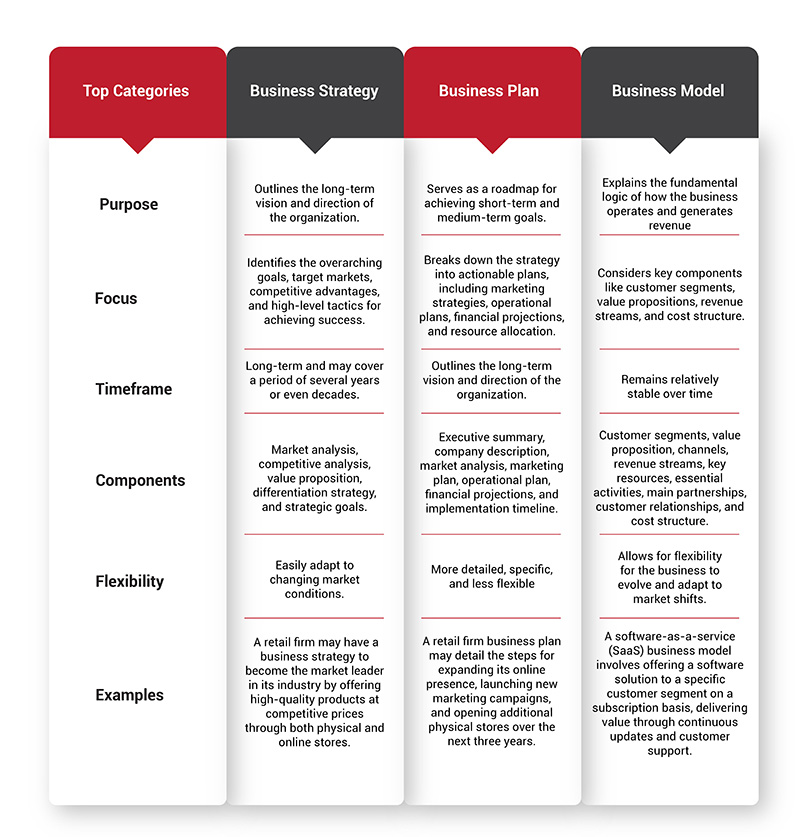
Levels of Business Strategy
Effective strategic management consists of coordination and alignment across various levels of strategy to achieve the organization's long-term goals and competitive advantage. Business strategy can be categorized into different levels depending on its scope, focus, and the organizational hierarchy at which it functions.
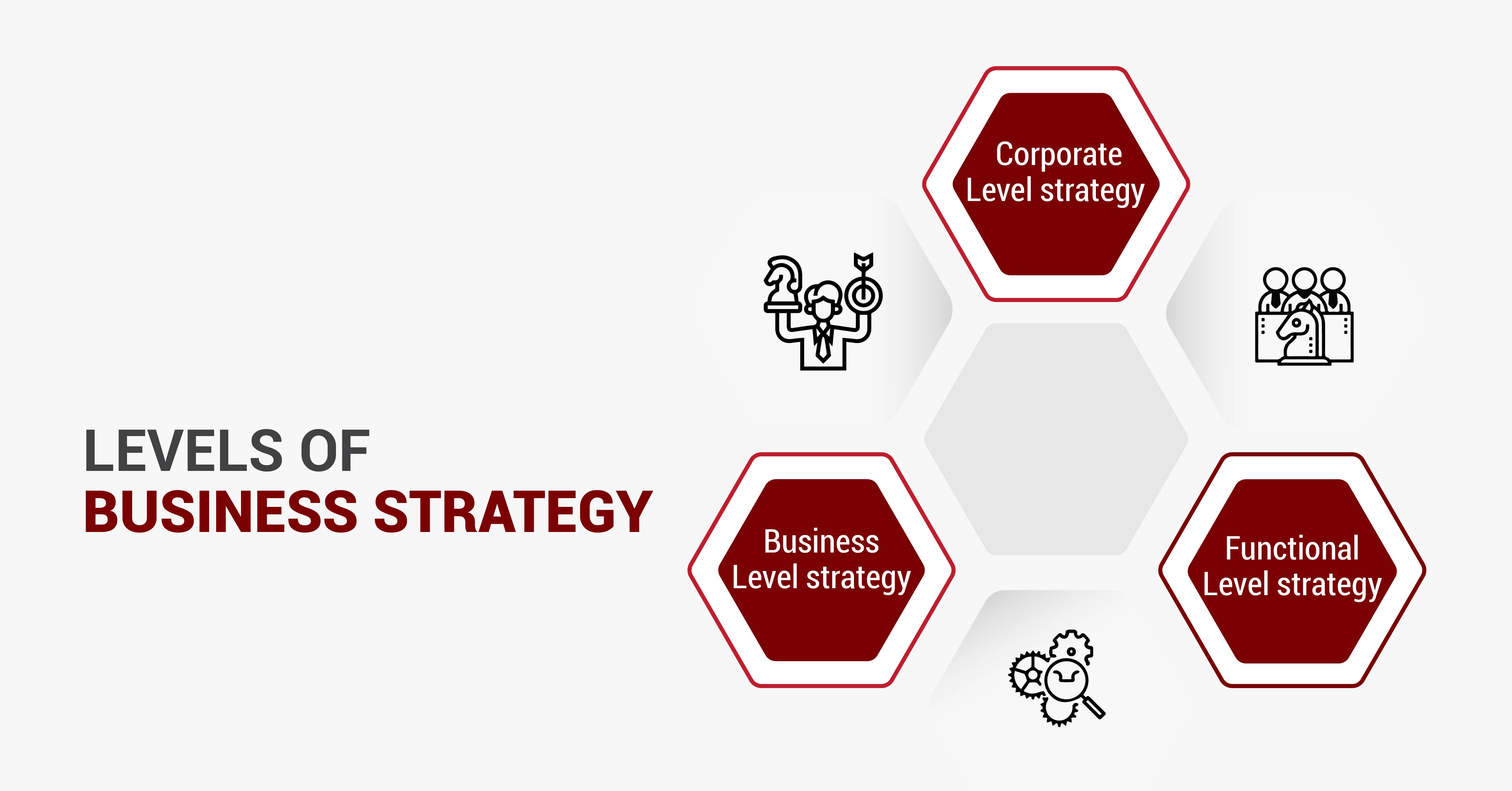
The three primary levels of business strategy are:
- Corporate level strategy Corporate level strategy is a long-range, action-oriented, integrated, and comprehensive plan, which is formulated by the top management of a company. It is very helpful to ascertain business lines, expansion, growth, takeovers and mergers, diversification , integration, and the latest fields for investment.
- Business level strategy The strategies that relate to a specific business are known as business-level strategies. It is developed by the general managers, who convert mission and vision into concrete, clear, and result-driven strategies. It acts like a blueprint for the total business.
- Functional level strategy Developed by the first-line managers or supervisors, the functional level strategy involves decision-making at the operational level concerning functional areas such as marketing, production, human resources, research and development, finance, and so on.
How to Implement a Successful Business Strategy?
A business strategist feels that it is tough to ideate any plan in a few hours. It requires a step-by-step procedure to be associated with completing a SWOT analysis . Here are the top steps that can be considered to build the best business strategies and execute them with precision:
- Understand the targets One of the clearest challenges for growth is poor targeting. Clear target markets offer an organization the ability to create an integrated sales and marketing approach, where marketing enables sales productivity. Sales and marketing business plan gets executed more efficiently if the targets are fixed in a proper way.
- Outline the tactics A successful business strategy is made up of several various tactics, including both online and offline options. The goals, target audience, and industry factor into this decision. For instance, if the target audience is young, focusing on social media is more beneficial as this is primarily where this group consumes content. If the industry is product-based (for instance, jewelry designing), then using a more visual platform would better showcase the products. To be most effective, one must choose which methods are right for the business. Once the selection of tactics is done, list them in the plan and determine how they’ll help to reach the goals.
- Think long term In the scope of constant change, planning the horizons is usually shorter than it can be. However, only thinking quarter to quarter is a trap that may rob organizations of their ability to see around the bend. Best-in-class organizations create processes designed for a series of financial and non-financial metrics to treat strategy as an annual cycle rather than a one-time, static event.
- Create a timeline Time is precious mainly when it is about the business. Based on the goals and objectives one can set for the business. Creating a timeline that will define what tasks can be completed and when they can be completed. It is highly advisable to allocate extra time for unexpected events that may delay some of the goals.
- Focus on growth A thriving organization is a growing organization. It is only through growth that the firms can afford to invest in aspects such as technology, the best staff, and the latest tools. The business strategy should identify the segments where an organization will grow and in what proportion.
- Have a budget plan Creating a budget for the business strategy can inform the efforts by determining what can be done and cannot be. Choosing the most cost-effective options for the business ensures the success of the overall business strategy. This doesn’t have to limit the options. Paid advertising on social media and search engines gives access to manage budgets well.
- Make fact-based decisions Several executives often complain about a lack of fruitful data, but they consistently find information that is useful in the formation of business strategy. The business has a set of values that guides it. Making fact-based decisions will outline the values and ensure that the people who interact with the business are aware of them. It will also ease the message that reflects on the brand honestly so it can actively demonstrate the values outlined in the mission statement through the interactions with clients.
- Invest in pre-work Always allocate time to do proper pre-work so that one can be up to date. It is better to conduct proper end-to-end research and prepare relevant information in advance of the business strategy meetings. The goals and needs will change over time. Ideally, it is important to revisit the business plan every annum to make adjustments as needed. Follow industry news and trends that can add to the existing strategy.
- Execute well and measure results Measuring the effectiveness of the business strategy will inform the current plan and future efforts. Always be sure to track and measure the business so these measurements are effective. Set up a corporate calendar to enhance the productive meetings, and also to form a performance management cycle. One should write the marketing plan with this growth in mind so they can measure it. The execution of strategic planning needs discipline, and it must be taken care of by the senior executives to promote processes that keep the team focused.
Examples of Business Strategy
Hubspot developed and executed a perfect business strategy where it created a market that didn’t even exist – inbound marketing. It created an online resource guide explaining the limitations of interruption marketing and informing about the advantages of inbound marketing. The organizations even offered free courses to help the target audience understand its offering better.
Apple Inc. differentiated its Smartphone operating system iOS by making it simple as compared to Android. This differentiated it and built its followership. The organization has been following a similar business strategy for its other products as well.
Wrapping up
Establishing the business strategy keeps the business goals organized and focused, saving valuable time and money. With the increase in the competition, the demand for business strategy is becoming apparent and there is a tremendous increase in the types of business strategies used by the businesses.

Recent Posts

How Data Analytics Can Revolutionize Your Business - A Strategist's Guide
Download this Strategist's Guide to empower yourself with resourceful insights:
- Roadblocks to Data Usage
- Advantages that Data Analytics offer for businesses
- Elements of a Data Analytics Strategy
- Top reasons why businesses must adopt a Data Analytics Strategy
- Case studies, Scenarios, and more

CredBadge™ is a proprietary, secure, digital badging platform that provides for seamless authentication and verification of credentials across digital media worldwide.
CredBadge™ powered credentials ensure that professionals can showcase and verify their qualifications and credentials across all digital platforms, and at any time, across the planet.

Verify A Credential
Please enter the License Number/Unique Credential Code of the certificant. Results will be displayed if the person holds an active credential from TSI.
Stay Informed!
Keep yourself informed on the latest updates and information about business strategy by subscribing to our newsletter.
Start Your Journey with The Strategy Institute by Creating Your myTSI Account Today.
- Manage your professional profile conveniently.
- Manage your credentials anytime.
- Share your experiences and ideas with The Strategy Institute.
Account Login
- Remember Password
- Forgot Password?
Forgot Password
More Like this
What is the difference between a business plan and a strategic plan.
It is not uncommon that the terms ‘strategic plan’ and ‘business plan’ get confused in the business world. While a strategic plan is a type of business plan, there are several important distinctions between the two types that are worth noting. Before beginning your strategic planning process or strategy implementation, look at the article below to learn the key difference between a business vs strategic plan and how each are important to your organization.
Definition of a business plan vs. a strategic plan
A strategic plan is essential for already established organizations looking for a way to manage and implement their strategic direction and future growth. Strategic planning is future-focused and serves as a roadmap to outline where the organization is going over the next 3-5 years (or more) and the steps it will take to get there.
Get the Free Guide for Setting OKRs that Work (with 100 examples!)
A strategic plan serves 6 functions for an organization that is striving to reach the next level of their growth:.
- Defines the purpose of the organization.
- Builds on an organization’s competitive advantages.
- Communicates the strategy to the staff.
- Prioritizes the financial needs of the organization.
- Directs the team to move from plan to action.
- Creates long-term sustainability and growth impact
Alternatively, a business plan is used by new businesses or organizations trying to get off the ground. The fundamentals of a business plan focus on setting the foundation for the business or organization. While it looks towards the future, the focus is set more on the immediate future (>1 year). Some of the functions of a business plan may overlap with a strategic plan. However, the focus and intentions diverge in a few key areas.
A business plan for new businesses, projects, or organizations serves these 5 functions:
- Simplifies or explains the objectives and goals of your organization.
- Coordinates human resource management and determines operational requirements.
- Secures funding for your organization.
- Evaluates potential business prospects.
- Creates a framework for conceptualizing ideas.
In other words, a strategic plan is utilized to direct the momentum and growth of an established company or organization. In contrast, a business plan is meant to set the foundation of a newly (or not quite) developed company by setting up its operational teams, strategizing ways to enter a new market, and obtaining funding.
A strategic plan focuses on long-term growth and the organization’s impact on the market and its customers. Meanwhile, a business plan must focus more on the short-term, day-to-day operational functions. Often, new businesses don’t have the capacity or resources to create a strategic plan, though developing a business plan with strategy elements is never a bad idea.
Business and strategic plans ultimately differ in several key areas–timeframe, target audience, focus, resource allocation, nature, and scalability.
While both a strategic and business plan is forward-facing and focused on future success, a business plan is focused on the more immediate future. A business plan normally looks ahead no further than one year. A business plan is set up to measure success within a 3- to 12-month timeframe and determines what steps a business owner needs to take now to succeed.
A strategic plan generally covers the organizational plan over 3 to 5+ years. It is set with future expansion and development in mind and sets up roadmaps for how the organization will reach its desired future state.
Pro Tip: While a vision statement could benefit a business plan, it is essential to a strategic plan.
Target Audience
A strategic plan is for established companies, businesses, organizations, and owners serious about growing their organizations. A strategic plan communicates the organization’s direction to the staff and stakeholders. The strategic plan is communicated to the essential change makers in the organization who will have a hand in making the progress happen.
A business plan could be for new businesses and entrepreneurs who are start-ups. The target audience for the business plan could also be stakeholders, partners, or investors. However, a business plan generally presents the entrepreneur’s ideas to a bank. It is meant to get the necessary people onboard to obtain the funding needed for the project.
A strategic plan provides focus, direction, and action to move the organization from where they are now to where they want to go. A strategic plan may consist of several months of studies, analyses, and other processes to gauge an organization’s current state. The strategy officers may conduct an internal and external analysis, determine competitive advantages, and create a strategy roadmap. They may take the time to redefine their mission, vision, and values statements.
Alternatively, a business plan provides a structure for ideas to define the business initially. It maps out the more tactical beginning stages of the plan.
Pro Tip: A mission statement is useful for business and strategic plans as it helps further define the enterprise’s value and purpose. If an organization never set its mission statement at the beginning stages of its business plan, it can create one for its strategic plan.
A strategic plan is critical to prioritizing resources (time, money, and people) to grow the revenue and increase the return on investment. The strategic plan may start with reallocating current financial resources already being utilized more strategically.
A business plan will focus on the resources the business still needs to obtain, such as vendors, investors, staff, and funding. A business plan is critical if new companies seek funding from banks or investors. It will add accountability and transparency for the organization and tell the funding channels how they plan to grow their business operations and ROI in the first year of the business.
The scalability of a business plan vs. strategic plan
Another way to grasp the difference is by understanding the difference in ‘scale’ between strategic and business plans. Larger organizations with multiple business units and a wide variety of products frequently start their annual planning process with a corporate-driven strategic plan. It is often followed by departmental and marketing plans that work from the Strategic Plan.
Smaller and start-up companies typically use only a business plan to develop all aspects of operations of the business on paper, obtain funding and then start the business.
Why understanding the differences between a business plan vs a strategic plan matters
It is important to know the key differences between the two terms, despite often being used interchangeably. But here’s a simple final explanation:
A business plan explains how a new business will get off the ground. A strategic plan answers where an established organization is going in the future and how they intend to reach that future state.
A strategic plan also focuses on building a sustainable competitive advantage and is futuristic. A business plan is used to assess the viability of a business opportunity and is more tactical.
10 Comments
I agree with your analysis about small companies, but they should do a strategic plan. Just check out how many of the INC 500 companies have an active strategic planning process and they started small. Its about 78%,
Strategic management is a key role of any organization even if belong to small business. it help in growth and also to steam line your values. im agree with kristin.
I agree with what you said, without strategic planning no organization can survive whether it is big or small. Without a clear strategic plan, it is like walking in the darkness.. Best Regards..
Vision, Mission in Business Plan VS Strategic Plan ?
you made a good analysis on strategic plan and Business plan the difference is quite clear now. But on the other hand, it seems that strategic plan and strategic management are similar which I think not correct. Please can you tell us the difference between these two?. Thanks
Thank you. I get points to work on it
super answer Thanking you
Hi. I went through all the discussions, comments and replies. Thanks! I got a very preliminary idea about functions and necessity of Strategic Planning in Business. But currently I am looking for a brief nice, flowery, juicy definition of “Business Strategic Planning” as a whole, which will give anyone a fun and interesting way to understand. Can anyone help me out please? Awaiting replies…… 🙂
that was easy to understand,
Developing a strategic plan either big or small company or organization mostly can’t achieve its goal. A strategic plan or formulation is the first stage of the strategic management plan, therefore, we should be encouraged to develop a strategic management plan. We can develop the best strategic plan but without a clear plan of implementation and evaluation, it will be difficult to achieve goals.
Comments Cancel
Join 60,000 other leaders engaged in transforming their organizations., subscribe to get the latest agile strategy best practices, free guides, case studies, and videos in your inbox every week..

Leading strategy? Join our FREE community.
Become a member of the chief strategy officer collaborative..

Free monthly sessions and exclusive content.
Do you want to 2x your impact.
Free MS Word Strategic Planning Templates
By Courtney Patterson | May 11, 2024
- Share on Facebook
- Share on LinkedIn
Link copied
Below is a collection of the best strategic planning templates in Microsoft Word to help you create a comprehensive roadmap for future growth and success.
Included in this article, you'll find:
- A one-page business strategy template
- A Microsoft Word IT Strategic Plan Template
- A 5-year strategic business plan template
- A nonprofit strategic plan template
- A list of related strategic planning templates
Microsoft Word Basic Strategic Plan Template
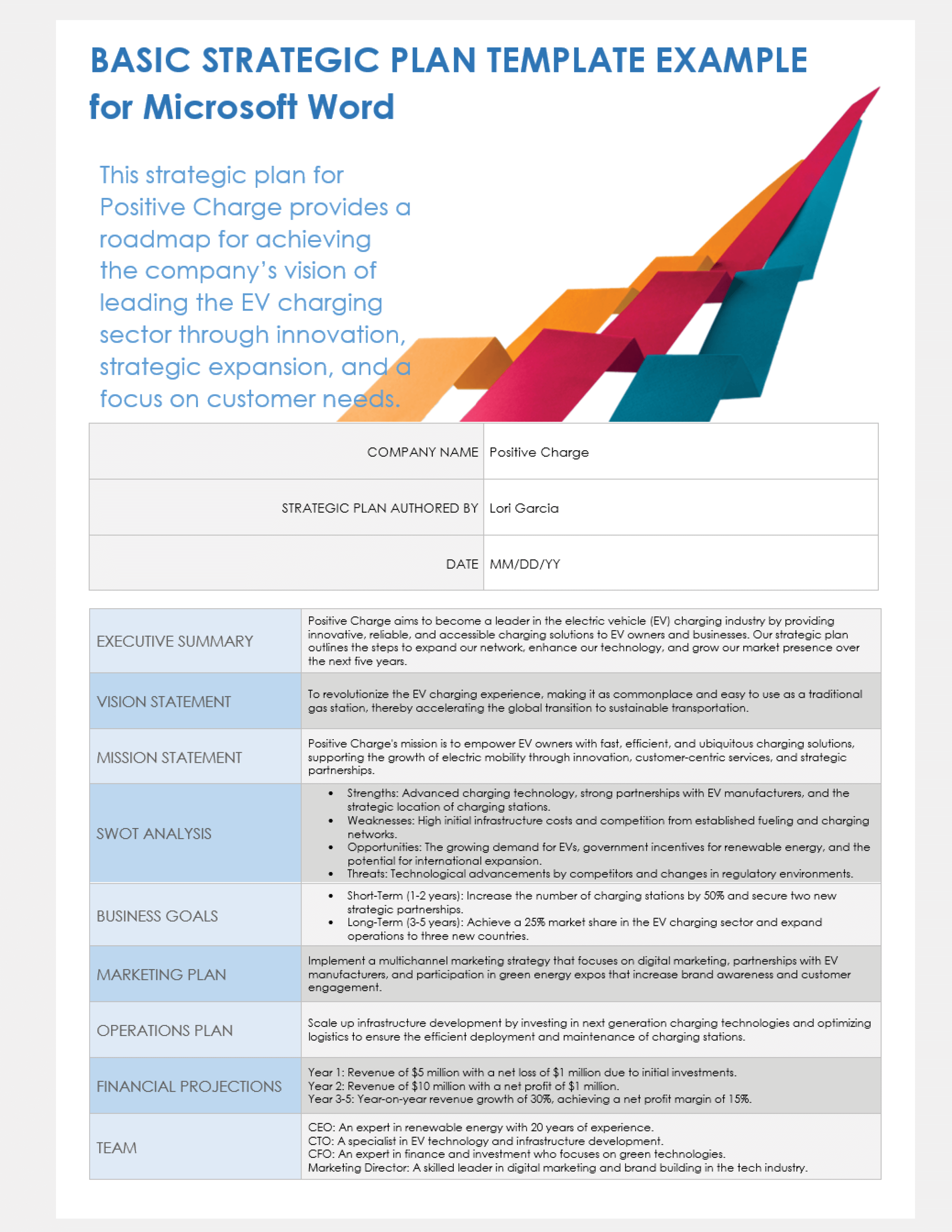
Download the Sample Basic Strategic Plan Template for Microsoft Word Download the Blank Basic Strategic Plan Template for Microsoft Word
When to Use This Template : Use this template with or without sample data when you are starting your business and need to outline a clear direction and foundational strategies. This tool is crucial for transitioning from an informal approach to a more structured strategic planning process.
Notable Template Features : This basic strategic plan template simplifies the planning process with a clear, easy-to-follow structure that covers essential strategic elements. It includes sections for mission and vision statements, a SWOT analysis, goals, and action plans, making it accessible for first-time strategists.
Check out these free strategic planning templates that offer robust resources, including ready-to-use frameworks and expert advice, so you can meticulously craft and execute your strategic vision.
Microsoft Word One-Page Business Strategic Plan Template
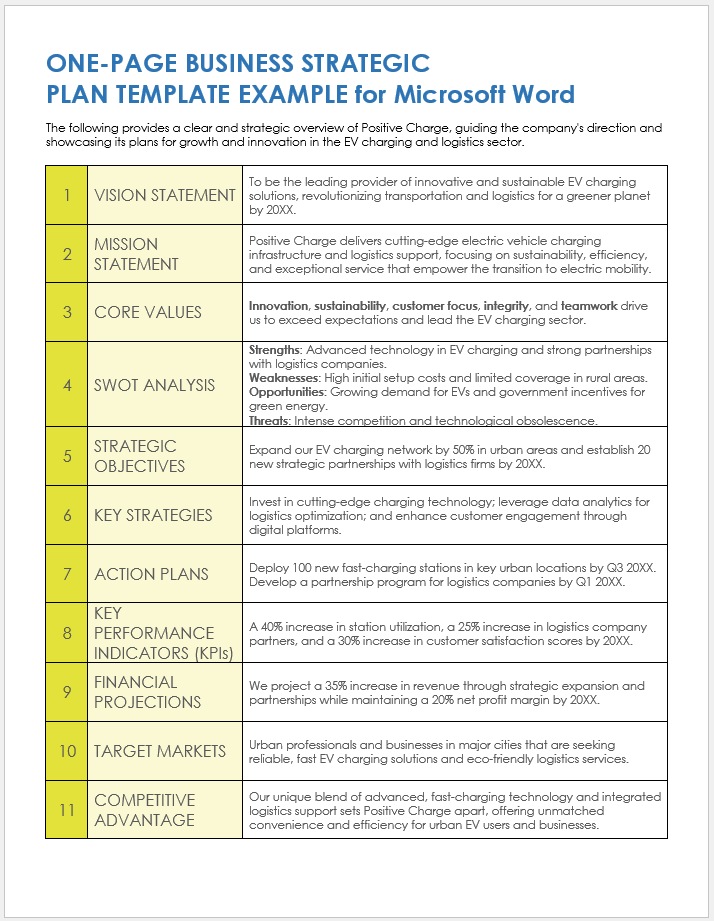
Download Sample One-Page Business Strategic Plan Template for Microsoft Word Download Blank One-Page Business Strategic Plan Template for Microsoft Word
When to Use This Template : Consider this template when you’re on a deadline and need a swift, comprehensive snapshot of your strategy. Available with or without sample data, the template is ideal for pre-meeting preparations, allowing you to quickly and thoroughly review your strategic position.
Notable Template Features : This one-page business strategic plan template boils down intricate strategies to a single, accessible page. Featuring streamlined sections for goals, actions, and metrics, it delivers a clear and concise strategic outline that's easy to share and discuss. Download the sample version for a pre-filled template, or try the blank version to fill in the sections with your own data.
Check out this strategic planning guide , complete with free templates that offer you all the tools and insights you need to expertly develop and implement your strategic plans.
Microsoft Word IT Strategic Plan Template
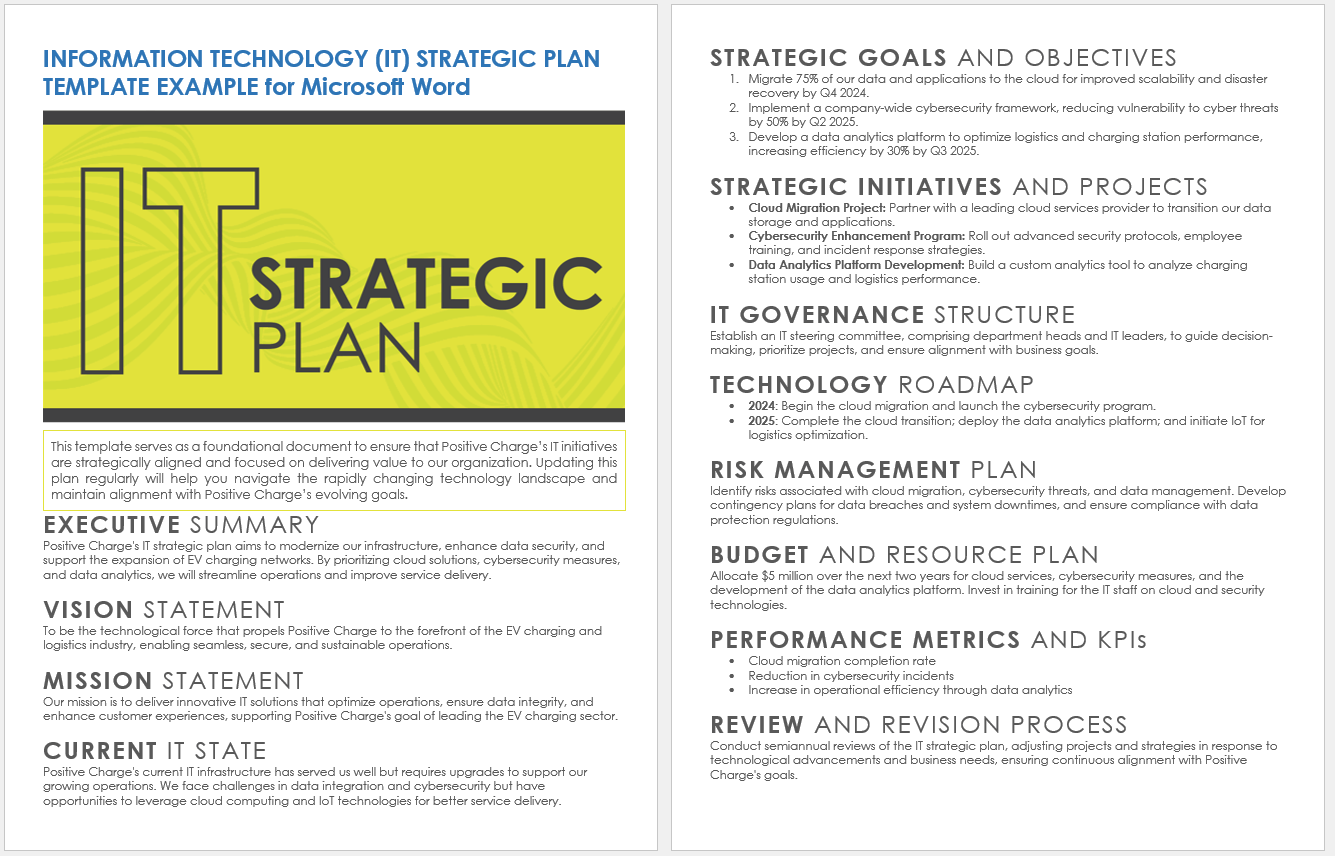
Download Microsoft Word IT Strategic Plan Template Download Sample IT Strategic Plan Template
When to Use This Template : Dive into this template when your IT department is gearing up for a major overhaul or aligning with new business strategies. Available with or without example text, the template is a must-have for plotting out the technological roadmap that supports your organization's long-term vision.
Notable Template Features : This IT strategic plan template features IT-specific sections, such as technology assessments and future roadmaps, making it a powerhouse for managing and planning IT investments. The template includes detailed prompts, so you can thoroughly address and align each aspect of your IT strategy, from cybersecurity to cloud computing, with overarching business objectives.
Explore this article on crafting strategic plans . It offers a treasure trove of free templates to guide your team through the strategic planning process, ensuring a seamless and effective strategy formulation.
Microsoft Word Advanced Strategic Planning Template
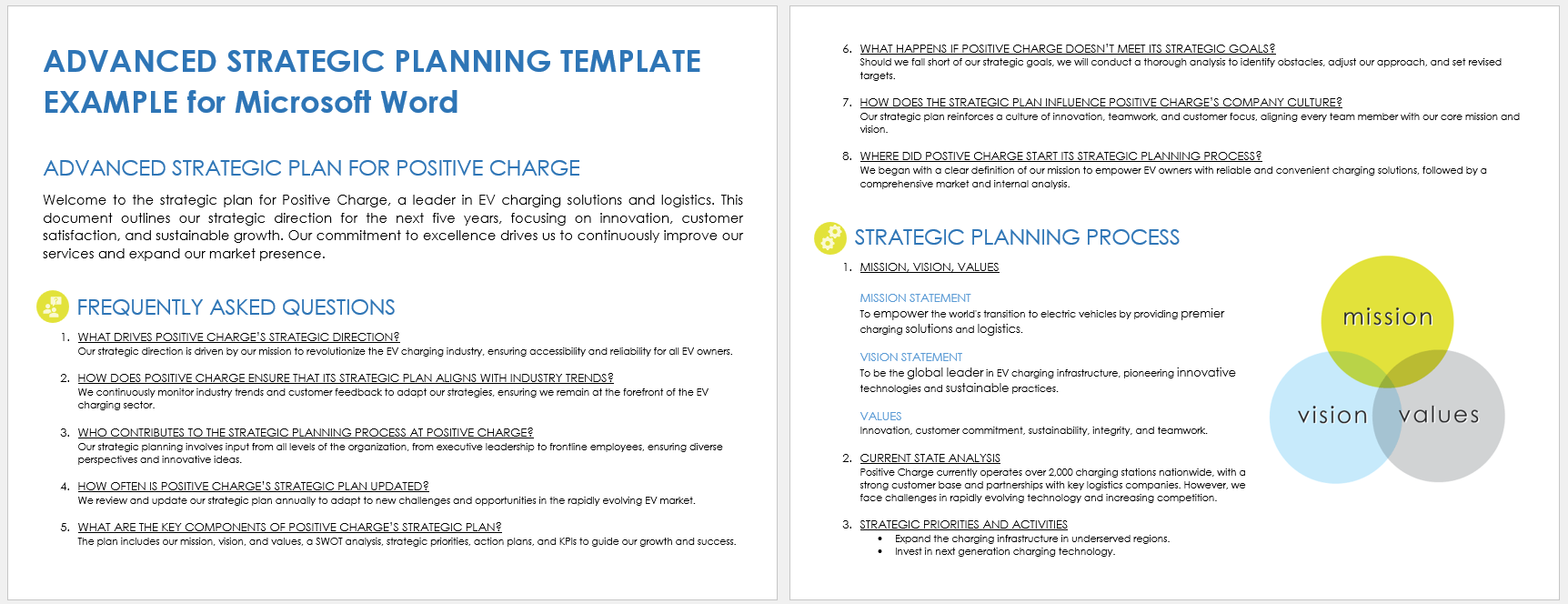
Download the Sample Advanced Strategic Planning Template for Microsoft Word Download the Blank Advanced Strategic Planning Template for Microsoft Word
When to Use This Template : Turn to this dynamic template with or without sample data when you’re ready to plan an all-inclusive strategy. Perfect for times of significant growth or change, it's especially useful for teams looking to blend comprehensive market insights with long-term planning.
Notable Template Features : This advanced strategic planning template is designed to guide you through every facet of strategic development, from SWOT analysis to detailed financial planning. Offering structured sections for an all-encompassing view of your business landscape, it ensures that you have a robust foundation for decision-making and future growth. Download the sample version for a pre-filled template, or try the blank version to fill in your own data.
Dive into this comprehensive guide on strategic planning model templates to access a diverse array of free resources and streamline the path to your strategic goals.
Microsoft Word One-Year Strategic Business Plan Template
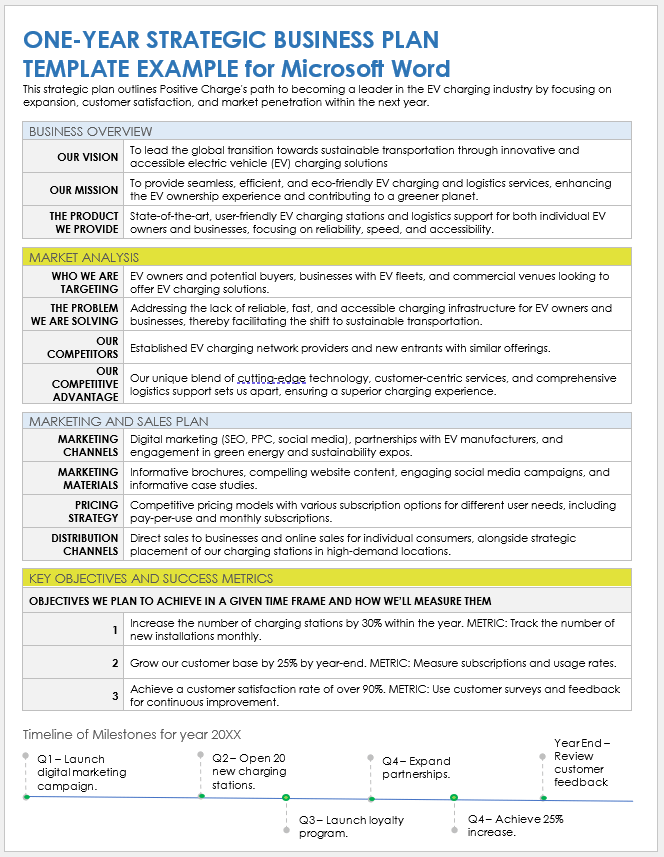
Download Sample One-Year Strategic Business Plan Template for Microsoft Word Download Blank One-Year Strategic Business Plan Template for Microsoft Word
When to Use This Template : Use this one-year template with or without sample data to reach your key goals within the next year. It's a must for companies looking to translate annual objectives into clear, actionable steps.
Notable Template Features : This one-year strategic business plan template is designed with simplicity in mind, featuring sections that help break down goals into achievable actions and timelines. The template’s streamlined approach ensures that you can focus on what matters most, making it easier to track progress and adjust strategies as needed.
Microsoft Word 5-Year Strategic Business Plan Template
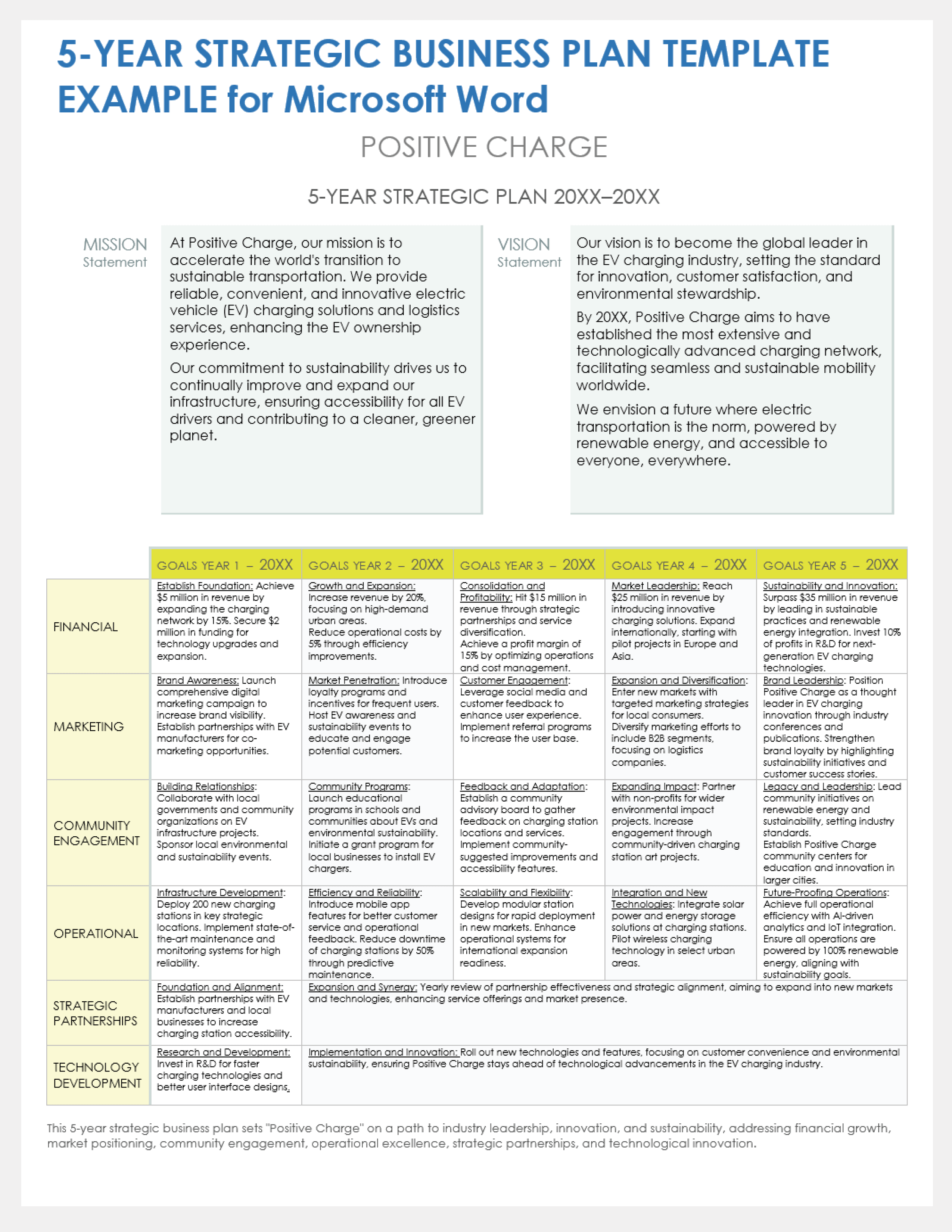
Download the Sample 5-Year Strategic Business Plan Template for Microsoft Word Download the Blank 5-Year Strategic Business Plan Template for Microsoft Word
When to Use This Template : Use this template to lay the strategic groundwork for the medium-term achievements your organization aims to reach in the next five years. Available with or without sample text, it's perfect for transitioning from startup to established entity, allowing you to focus on expansion and scalability.
Notable Template Features : This 5-year strategic business plan template empowers you to set ambitious yet attainable goals and create strategies for market expansion. It also includes tools for financial forecasting and resource allocation, making it easier to manage growth and measure success over a longer period.
Microsoft Word Long-Term Strategic Business Plan Template
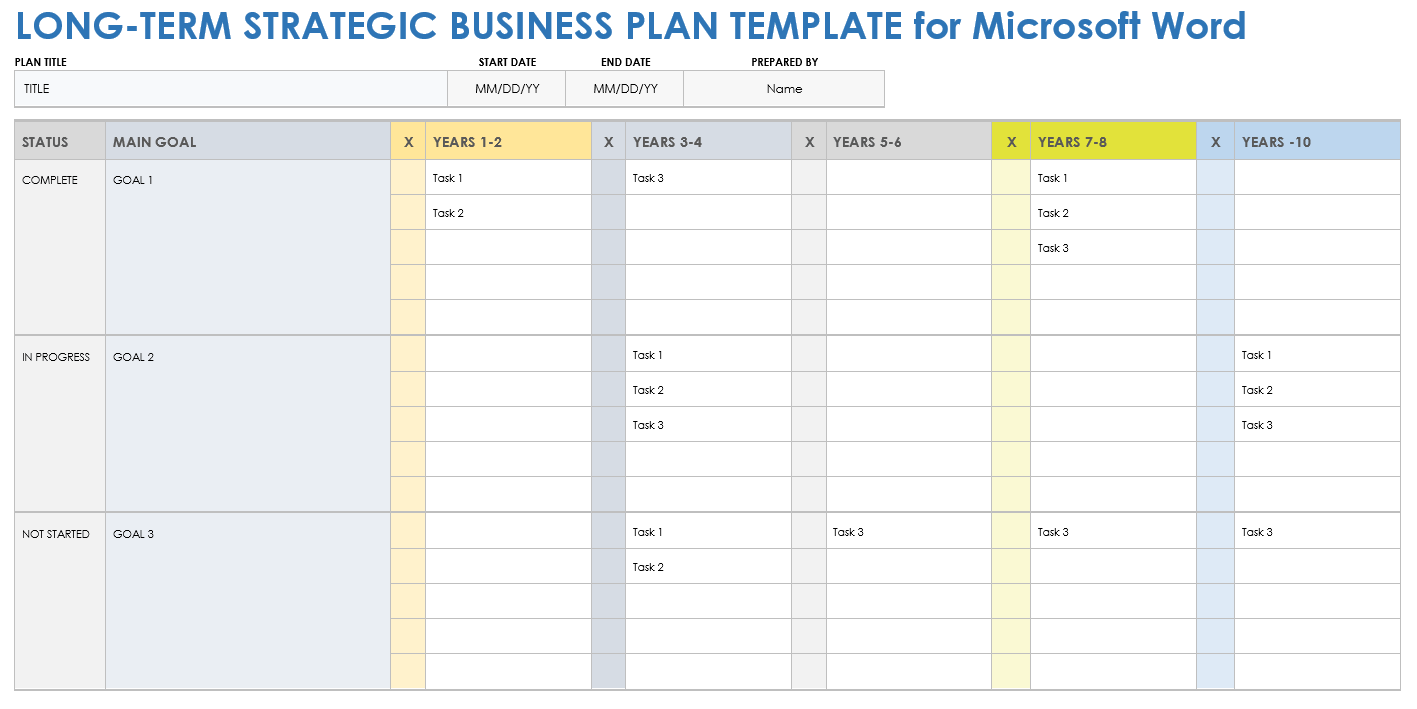
Download the Long-Term Strategic Business Plan Template for Microsoft Word
When to Use This Template : Use this template when you’re aiming for a plan of 10 years or longer and envisioning your business's journey toward long-term innovation and industry leadership.
Notable Template Features : Featuring a decade-spanning outlook, this long-term strategic plan template empowers you to set visionary goals and detailed strategies for sustainable growth and innovation. It’s designed to help you align your long-range plans with actionable steps, ensuring every department is moving toward a common, ambitious future.
Microsoft Word University Strategic Plan Outline Template
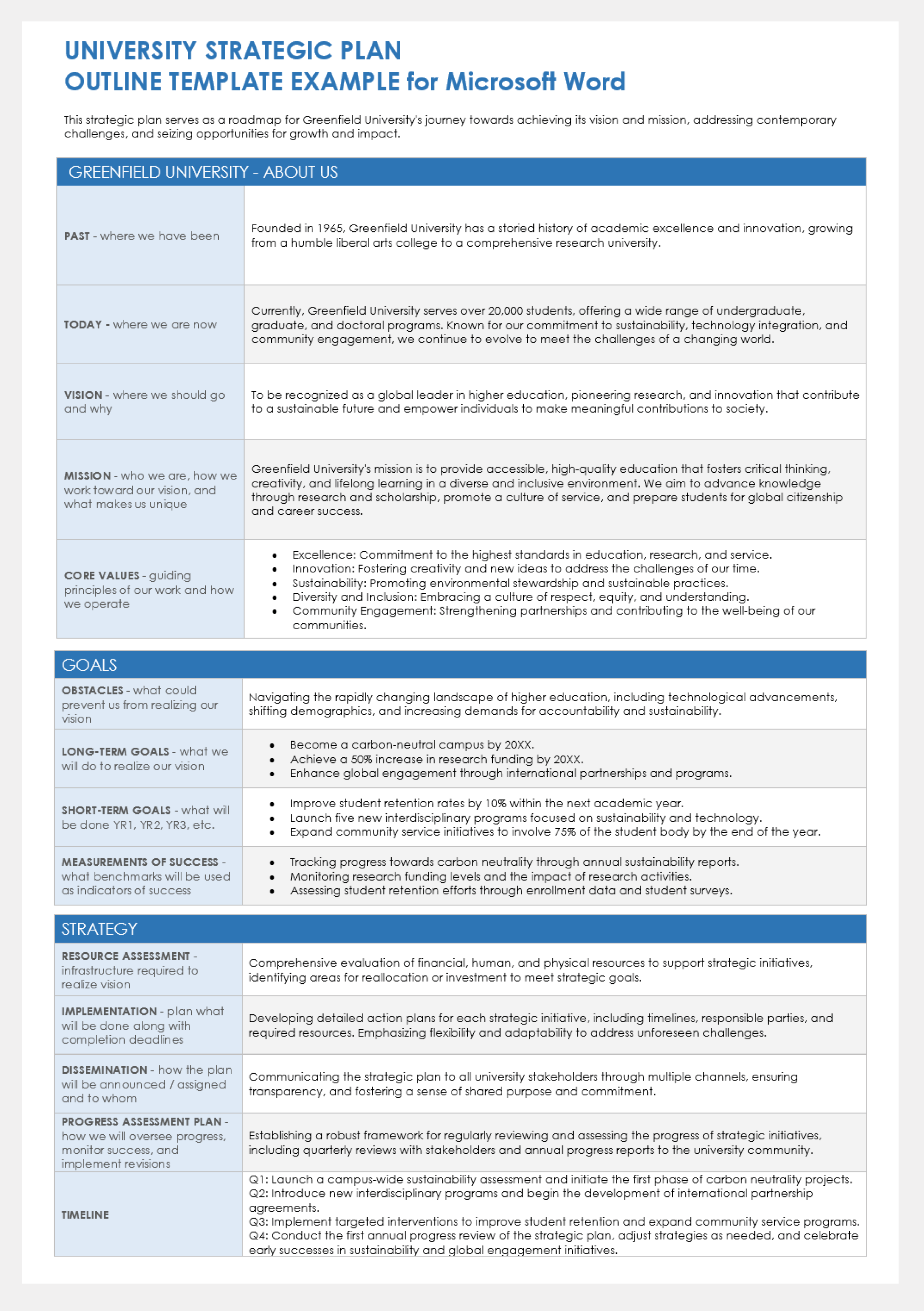
Download Sample University Strategic Plan Outline Template for Microsoft Word Download Blank University Strategic Plan Outline Template for Microsoft Word
When to Use This Template : This template helps university leaders chart a future course that enriches academic excellence and campus life. Use it during periods of strategic reflection or in advance of accreditation reviews to ensure all goals align with the institution's mission and vision.
Notable Template Features : Tailored to the academic sector, this strategic plan outline includes sections for setting educational priorities, creating a strategy for program development, and planning campus enhancements. Available with or without example text, it facilitates a comprehensive approach to institutional growth, encouraging stakeholder engagement and long-term planning for academic and infrastructural improvements.
Microsoft Word Marketing Strategic Planning Template
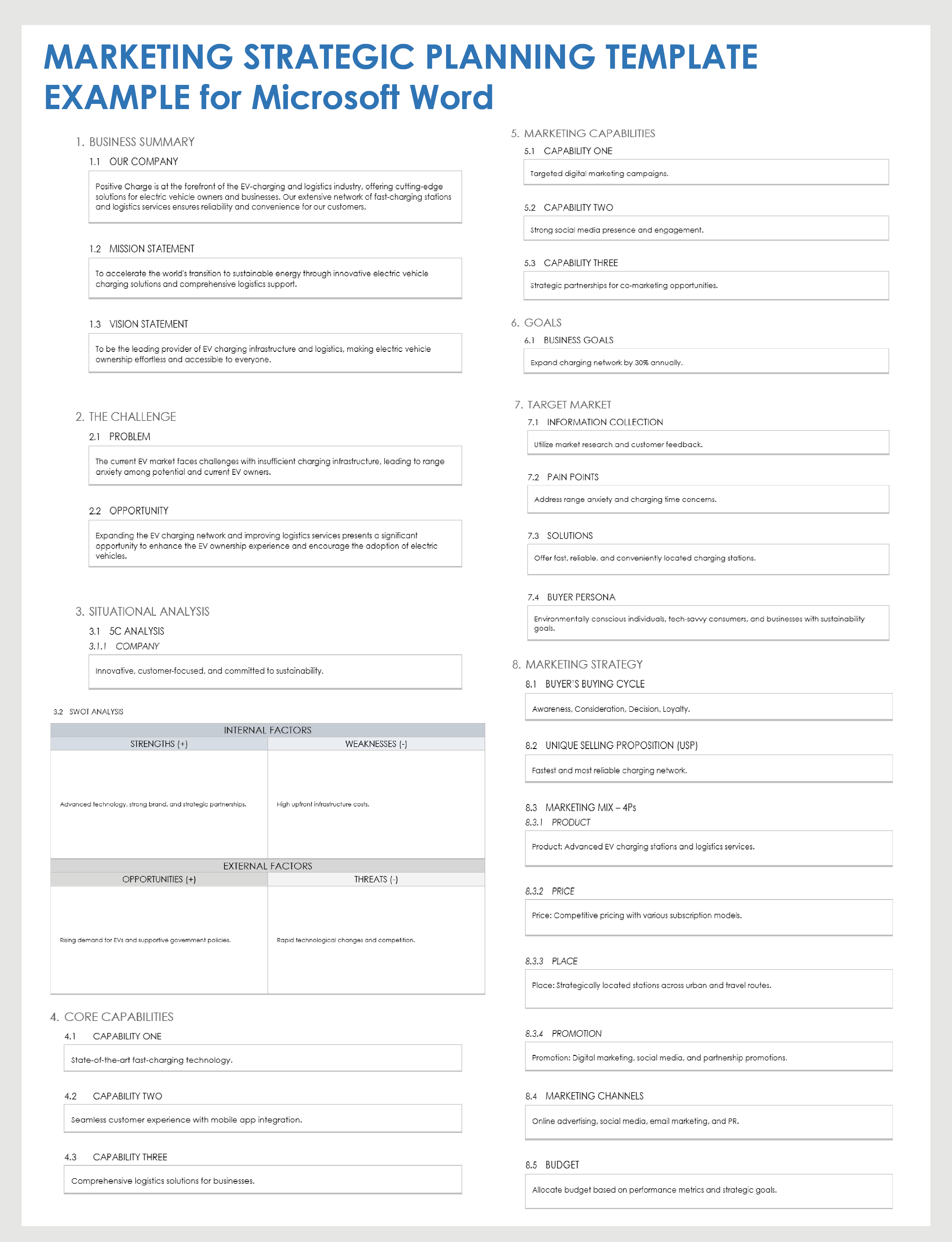
Download the Sample Marketing Strategic Planning Template for Microsoft Word Download the Blank Marketing Strategic Planning Template for Microsoft Word
When to Use This Template : Turn to this template when you're preparing to put a new product on the market or revamping your brand's presence. It's ideal for synchronizing your marketing initiatives with your overarching business goals.
Notable Template Features : This template with or without sample data stands out with its clear sections for defining marketing objectives, pinpointing your audience, and crafting detailed campaign strategies. It supports marketers by laying out a comprehensive plan that not only attracts but also retains customers, ensuring all marketing activities are in lockstep with the business's vision and objectives. Try the pre-filled template to see sample text, or use the blank template to fill in your own data.
Microsoft Word Nonprofit Strategic Plan Template
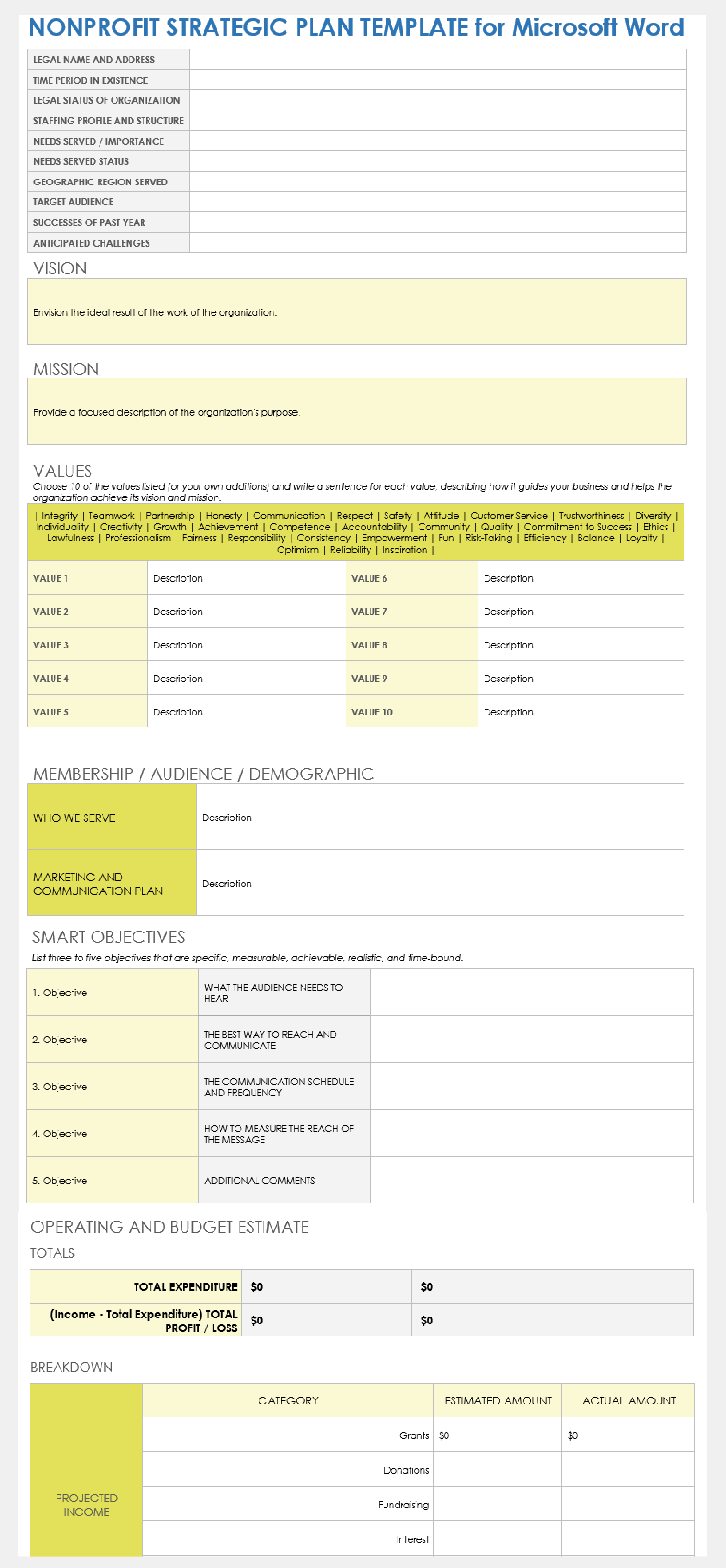
Download the Nonprofit Strategic Plan Template for Microsoft Word
When to Use This Template : Reach for this template when your nonprofit is gearing up for a period of strategic renewal or aiming to better align its efforts with its core mission. Helping you clearly articulate your organization's direction and impact, this tool is crucial for running annual planning sessions or preparing funding and grant applications.
Notable Template Features : This template is designed specifically for nonprofit organizations, featuring sections dedicated to mission statement clarification, stakeholder engagement strategies, and impact assessment methods. It offers a comprehensive framework for nonprofits to navigate the complexities of sustainability and mission-driven planning, ensuring every activity contributes to long-term success.
Related Strategic Planning Templates
Discover this list of free templates that perfectly complement your strategic planning needs. From business model canvases to detailed market analyses and customer journeys, these tools ensure a solid value proposition and guide your business toward success.
Free Microsoft Word Action Plan Templates
Check out these free Microsoft Word action plan templates for tools to streamline your project planning, enhance your task management, and achieve your goals more efficiently.

Free Gap Analysis Templates
Explore this collection of free gap analysis templates to help you identify the discrepancies between your business's current state and its desired future state, offering a clear pathway for strategic improvement and goal achievement.

Free Scenario Analysis Templates
Use these free scenario analysis templates to get frameworks that prepare you for various future possibilities, enabling strategic decision-making and risk management.
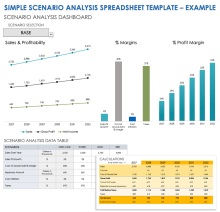
Secure Your Organization’s Future Success with Strategic Planning Templates from Smartsheet
Empower your people to go above and beyond with a flexible platform designed to match the needs of your team — and adapt as those needs change.
The Smartsheet platform makes it easy to plan, capture, manage, and report on work from anywhere, helping your team be more effective and get more done. Report on key metrics and get real-time visibility into work as it happens with roll-up reports, dashboards, and automated workflows built to keep your team connected and informed.
When teams have clarity into the work getting done, there’s no telling how much more they can accomplish in the same amount of time. Try Smartsheet for free, today.
Discover why over 90% of Fortune 100 companies trust Smartsheet to get work done.
- SUGGESTED TOPICS
- The Magazine
- Newsletters
- Managing Yourself
- Managing Teams
- Work-life Balance
- The Big Idea
- Data & Visuals
- Reading Lists
- Case Selections
- HBR Learning
- Topic Feeds
- Account Settings
- Email Preferences
4 Strategies to Guide Your Team Through a Departmental Transition
- Susan Peppercorn
- Tony Martignetti

Start by communicating the “why” clearly and authentically.
Whether initiated by strategic realignment, leadership changes, or market demands, departmental transitions test a leader’s mettle. In this article, the authors offer four strategies to guide your team through a departmental transition while maintaining morale, productivity, and cohesion: 1) Communicate the “why” clearly and authentically. 2) Acknowledge the emotional impact. 3) Cultivate ownership and involvement. 4) Prepare your team for future changes.
Organizational change is constant in an era marked by rapid technological advancements, shifting market dynamics, and the lingering effects of a global pandemic. A survey by McKinsey & Company found that 80% of organizations have experienced some form of transformation in the past five years, yet only a third of these initiatives have been successful.
- Susan Peppercorn is an executive career transition coach and speaker. She is the author of Ditch Your Inner Critic at Work: Evidence-Based Strategies to Thrive in Your Career. Numerous publications including the New York Times, Wall Street Journal, Fast Company, the Boston Globe, and SELF Magazine have tapped her for career advice. You can download her free Career Fit Self-Assessment and 25 Steps to a Successful Career Transition .
- TM Tony Martignetti is the chief inspiration officer at Inspired Purpose Partners , where he advises leaders to stay grounded in chaotic times. He is the best-selling author of Climbing the Right Mountain: Navigating the Journey to An Inspired Life and Campfire Lessons for Leaders: How Uncovering Our Past Can Propel Us Forward .
Partner Center
Mobile Menu Overlay
The White House 1600 Pennsylvania Ave NW Washington, DC 20500
FACT SHEET: President Biden Takes Action to Protect American Workers and Businesses from China’s Unfair Trade Practices
President Biden’s economic plan is supporting investments and creating good jobs in key sectors that are vital for America’s economic future and national security. China’s unfair trade practices concerning technology transfer, intellectual property, and innovation are threatening American businesses and workers. China is also flooding global markets with artificially low-priced exports. In response to China’s unfair trade practices and to counteract the resulting harms, today, President Biden is directing his Trade Representative to increase tariffs under Section 301 of the Trade Act of 1974 on $18 billion of imports from China to protect American workers and businesses. The Biden-Harris Administration’s Investing in America agenda has already catalyzed more than $860 billion in business investments through smart, public incentives in industries of the future like electric vehicles (EVs), clean energy, and semiconductors. With support from the Bipartisan Infrastructure Law, CHIPS and Science Act, and Inflation Reduction Act, these investments are creating new American jobs in manufacturing and clean energy and helping communities that have been left behind make a comeback. As President Biden says, American workers and businesses can outcompete anyone—as long as they have fair competition. But for too long, China’s government has used unfair, non-market practices. China’s forced technology transfers and intellectual property theft have contributed to its control of 70, 80, and even 90 percent of global production for the critical inputs necessary for our technologies, infrastructure, energy, and health care—creating unacceptable risks to America’s supply chains and economic security. Furthermore, these same non-market policies and practices contribute to China’s growing overcapacity and export surges that threaten to significantly harm American workers, businesses, and communities. Today’s actions to counter China’s unfair trade practices are carefully targeted at strategic sectors—the same sectors where the United States is making historic investments under President Biden to create and sustain good-paying jobs—unlike recent proposals by Congressional Republicans that would threaten jobs and raise costs across the board. The previous administration’s trade deal with China failed to increase American exports or boost American manufacturing as it had promised. Under President Biden’s Investing in America agenda, nearly 800,000 manufacturing jobs have been created and new factory construction has doubled after both fell under the previous administration, and the trade deficit with China is the lowest in a decade—lower than any year under the last administration. We will continue to work with our partners around the world to strengthen cooperation to address shared concerns about China’s unfair practices—rather than undermining our alliances or applying indiscriminate 10 percent tariffs that raise prices on all imports from all countries, regardless whether they are engaged in unfair trade. The Biden-Harris Administration recognizes the benefits for our workers and businesses from strong alliances and a rules-based international trade system based on fair competition. Following an in-depth review by the United States Trade Representative, President Biden is taking action to protect American workers and American companies from China’s unfair trade practices. To encourage China to eliminate its unfair trade practices regarding technology transfer, intellectual property, and innovation, the President is directing increases in tariffs across strategic sectors such as steel and aluminum, semiconductors, electric vehicles, batteries, critical minerals, solar cells, ship-to-shore cranes, and medical products. Steel and Aluminum The tariff rate on certain steel and aluminum products under Section 301 will increase from 0–7.5% to 25% in 2024. Steel is a vital sector for the American economy, and American companies are leading the future of clean steel. Recently, the Biden-Harris Administration announced $6 billion for 33 clean manufacturing projects including for steel and aluminum, including the first new primary aluminum smelter in four decades, made possible by the Bipartisan Infrastructure Law and the Inflation Reduction Act. These investments will make the United States one of the first nations in the world to convert clean hydrogen into clean steel, bolstering the U.S. steel industry’s competitiveness as the world’s cleanest major steel producer. American workers continue to face unfair competition from China’s non-market overcapacity in steel and aluminum, which are among the world’s most carbon intensive. China’s policies and subsidies for their domestic steel and aluminum industries mean high-quality, low-emissions U.S. products are undercut by artificially low-priced Chinese alternatives produced with higher emissions. Today’s actions will shield the U.S. steel and aluminum industries from China’s unfair trade practices. Semiconductors The tariff rate on semiconductors will increase from 25% to 50% by 2025. China’s policies in the legacy semiconductor sector have led to growing market share and rapid capacity expansion that risks driving out investment by market-driven firms. Over the next three to five years, China is expected to account for almost half of all new capacity coming online to manufacture certain legacy semiconductor wafers. During the pandemic, disruptions to the supply chain, including legacy chips, led to price spikes in a wide variety of products, including automobiles, consumer appliances, and medical devices, underscoring the risks of overreliance on a few markets. Through the CHIPS and Science Act, President Biden is making a nearly $53 billion investment in American semiconductor manufacturing capacity, research, innovation, and workforce. This will help counteract decades of disinvestment and offshoring that has reduced the United States’ capacity to manufacture semiconductors domestically. The CHIPS and Science Act includes $39 billion in direct incentives to build, modernize, and expand semiconductor manufacturing fabrication facilities as well as a 25% investment tax credit for semiconductor companies. Raising the tariff rate on semiconductors is an important initial step to promote the sustainability of these investments. Electric Vehicles (EVs) The tariff rate on electric vehicles under Section 301 will increase from 25% to 100% in 2024. With extensive subsidies and non-market practices leading to substantial risks of overcapacity, China’s exports of EVs grew by 70% from 2022 to 2023—jeopardizing productive investments elsewhere. A 100% tariff rate on EVs will protect American manufacturers from China’s unfair trade practices. This action advances President Biden’s vision of ensuring the future of the auto industry will be made in America by American workers. As part of the President’s Investing in America agenda, the Administration is incentivizing the development of a robust EV market through business tax credits for manufacturing of batteries and production of critical minerals, consumer tax credits for EV adoption, smart standards, federal investments in EV charging infrastructure, and grants to supply EV and battery manufacturing. The increase in the tariff rate on electric vehicles will protect these investments and jobs from unfairly priced Chinese imports. Batteries, Battery Components and Parts, and Critical Minerals The tariff rate on lithium-ion EV batteries will increase from 7.5%% to 25% in 2024, while the tariff rate on lithium-ion non-EV batteries will increase from 7.5% to 25% in 2026. The tariff rate on battery parts will increase from 7.5% to 25% in 2024. The tariff rate on natural graphite and permanent magnets will increase from zero to 25% in 2026. The tariff rate for certain other critical minerals will increase from zero to 25% in 2024. Despite rapid and recent progress in U.S. onshoring, China currently controls over 80 percent of certain segments of the EV battery supply chain, particularly upstream nodes such as critical minerals mining, processing, and refining. Concentration of critical minerals mining and refining capacity in China leaves our supply chains vulnerable and our national security and clean energy goals at risk. In order to improve U.S. and global resiliency in these supply chains, President Biden has invested across the U.S. battery supply chain to build a sufficient domestic industrial base. Through the Bipartisan Infrastructure Law, the Defense Production Act, and the Inflation Reduction Act, the Biden-Harris Administration has invested nearly $20 billion in grants and loans to expand domestic production capacity of advanced batteries and battery materials. The Inflation Reduction Act also contains manufacturing tax credits to incentivize investment in battery and battery material production in the United States. The President has also established the American Battery Materials Initiative, which will mobilize an all-of-government approach to secure a dependable, robust supply chain for batteries and their inputs. Solar Cells The tariff rate on solar cells (whether or not assembled into modules) will increase from 25% to 50% in 2024. The tariff increase will protect against China’s policy-driven overcapacity that depresses prices and inhibits the development of solar capacity outside of China. China has used unfair practices to dominate upwards of 80 to 90% of certain parts of the global solar supply chain, and is trying to maintain that status quo. Chinese policies and nonmarket practices are flooding global markets with artificially cheap solar modules and panels, undermining investment in solar manufacturing outside of China. The Biden-Harris Administration has made historic investments in the U.S. solar supply chain, building on early U.S. government-enabled research and development that helped create solar cell technologies. The Inflation Reduction Act provides supply-side tax incentives for solar components, including polysilicon, wafers, cells, modules, and backsheet material, as well as tax credits and grant and loan programs supporting deployment of utility-scale and residential solar energy projects. As a result of President Biden’s Investing in America agenda, solar manufacturers have already announced nearly $17 billion in planned investment under his Administration—an 8-fold increase in U.S. manufacturing capacity, enough to supply panels for millions of homes each year by 2030. Ship-to-Shore Cranes The tariff rate on ship-to-shore cranes will increase from 0% to 25% in 2024. The Administration continues to deliver for the American people by rebuilding the United States’ industrial capacity to produce port cranes with trusted partners. A 25% tariff rate on ship-to-shore cranes will help protect U.S. manufacturers from China’s unfair trade practices that have led to excessive concentration in the market. Port cranes are essential pieces of infrastructure that enable the continuous movement and flow of critical goods to, from, and within the United States, and the Administration is taking action to mitigate risks that could disrupt American supply chains. This action also builds off of ongoing work to invest in U.S. port infrastructure through the President’s Investing in America Agenda. This port security initiative includes bringing port crane manufacturing capabilities back to the United States to support U.S. supply chain security and encourages ports across the country and around the world to use trusted vendors when sourcing cranes or other heavy equipment. Medical Products The tariff rates on syringes and needles will increase from 0% to 50% in 2024. For certain personal protective equipment (PPE), including certain respirators and face masks, the tariff rates will increase from 0–7.5% to 25% in 2024. Tariffs on rubber medical and surgical gloves will increase from 7.5% to 25% in 2026. These tariff rate increases will help support and sustain a strong domestic industrial base for medical supplies that were essential to the COVID-19 pandemic response, and continue to be used daily in every hospital across the country to deliver essential care. The federal government and the private sector have made substantial investments to build domestic manufacturing for these and other medical products to ensure American health care workers and patients have access to critical medical products when they need them. American businesses are now struggling to compete with underpriced Chinese-made supplies dumped on the market, sometimes of such poor quality that they may raise safety concerns for health care workers and patients. Today’s announcement reflects President Biden’s commitment to always have the back of American workers. When faced with anticompetitive, unfair practices from abroad, the President will deploy any and all tools necessary to protect American workers and industry.
Stay Connected
We'll be in touch with the latest information on how President Biden and his administration are working for the American people, as well as ways you can get involved and help our country build back better.
Opt in to send and receive text messages from President Biden.

College Savings Foundation Highlights Key 2024 Changes: Expert Vivian Tsai on Improved 529 Plans
MAY 15 2024
As the costs at some colleges near $100,000 a year, families need a savings strategy they can bank on. Financial experts and plan investors agree that 529 college savings plans are a smart choice for many. And, as of 2024, there are even more benefits, including higher contribution limits and the flexibility to roll unused money into a Roth individual retirement account free of tax penalties.

IMAGES
VIDEO
COMMENTS
Strategic planning is the ongoing organizational process of using available knowledge to document a business's intended direction. This process is used to prioritize efforts, effectively allocate resources, align shareholders and employees on the organization's goals, and ensure those goals are backed by data and sound reasoning. It's ...
Increased Operational Efficiency: Strategic planning improves operational efficiency by providing a roadmap for all activities. It reduces ambiguity, promotes alignment, and ensures that all efforts are coordinated and pointed in the same direction. Enhanced Market Responsiveness: Strategic planning allows organizations to be proactive rather ...
Strategic plans bridge the gap from overall direction to specific projects and day-to-day actions that ultimately execute the strategy. Job No. 1 is to know the difference between strategy and strategic plans — and why it matters. Strategy defines the long-term direction of the enterprise. It articulates what the enterprise will do to compete ...
A business strategy is foundational to a company's success. It helps leaders set organizational goals and gives companies a competitive edge. It determines various business factors, including: Price: How to price goods and services based on customer satisfaction and cost of raw materials.
A strategic business plan is a critical document for any organisation, regardless of its size or industry. It outlines the company's vision, mission, and objectives, as well as the strategies and tactics that will be used to achieve them. It also establishes a system for monitoring and measuring progress and making adjustments as needed.
On one hand, that definition makes strategy planning sound like a Business 101 concept—define your goals and a plan to achieve them. Unfortunately, the strategic planning process isn't as straightforward as it seems, especially for large companies. ... This absence of a strategic plan demonstrates why having one is so important. The ...
Step 1: Assess your current business strategy and business environment. Before you can define where you're going, you first need to define where you are. Understanding the external environment, including market trends and competitive landscape, is crucial in the initial assessment phase of strategic planning.
Strategic management is part of a larger planning process that includes budgeting, forecasting, capital allocation, and more. There is no right or wrong way to do strategic management — only guidelines. The basic phases are preparing for strategic planning, creating the strategic plan, and implementing that plan.
A strategic plan is a great tool to have in your arsenal. It is capable of helping your business achieve great things. Here are a few examples: Strategic planning can help you double the cash flow ...
Other companies use trigger mechanisms to decide which business units will undergo a full strategic-planning exercise in a given year. One industrial company assigns each business unit a color-coded grade—green, yellow, or red—based on the unit's success in executing the existing strategic plan.
Strategic planning is crucial for a business as it creates a map for a business to follow and course correct when need be. The first part of a strategic plan is the business plan, which outlines ...
Strategic planning is an opportunity for you and your employees to exchange ideas. While you can provide your employees with an interesting view of the business, they can share their own unique opinions. Because everyone is involved in the strategic planning process, it creates a sense of accountability for your employees.
Depending upon your goals, you need both a general business plan and a strategic plan — or many strategic plans. Because strategic plans are intended to help you reach short- to mid-range goals ...
Overcoming Challenges and Pitfalls. Challenge of consensus over clarity. Challenge of who provides input versus who decides. Preparing a long, ambitious, 5 year plan that sits on a shelf. Finding a balance between process and a final product. Communicating and executing the plan. Lack of alignment between mission, action, and finances.
A good strategic plan evolves and shifts as opportunities and threats arise. "Most people think of strategy as an event, but that's not the way the world works," says Harvard Business School Professor Clayton Christensen in the online course Disruptive Strategy. "When we run into unanticipated opportunities and threats, we have to respond.
The steps below will guide you through the process of creating a business plan and what key components you need to include. 1. Create an executive summary. Start with a brief overview of your entire plan. The executive summary should cover your business plan's main points and key takeaways.
The goal of developing a strategic plan is to ensure everyone in the business is aligned when it comes to your small business's goals and objectives, as well as to create a formal strategic plan document. 1. Discussion Phase. The discussion phase is meant to gather as much information, opinions, and input as possible.
However, enthusiasm for strategic business planning was revived in the 1990s and strategic planning remains relevant in modern business. ... While planning requires a significant amount of time, effort, and money, a well-thought-out strategic plan efficiently fosters company growth, goal achievement, and employee satisfaction. Additional Resources.
Corporate level strategy is a long-range, action-oriented, integrated, and comprehensive plan, which is formulated by the top management of a company. It is very helpful to ascertain business lines, expansion, growth, takeovers and mergers, diversification, integration, and the latest fields for investment.
An annual strategic business plan should include 8 key sections. Follow these steps to write an effective annual strategic business plan: State information that defines the company. Perform a SWOT analysis. Identify business goals. Identify key performance indicators. Perform and summarize market research. Outline the business marketing plan.
What is a strategic plan? In contrast to a business plan, a strategic plan sets out a company's goals and defines the actions it takes to get there. The audience is your own team. Its key purpose is to build alignment and decision-making capacity to ready your company for the future. For example, if a company's business model is ...
A strategic plan answers where an established organization is going in the future and how they intend to reach that future state. A strategic plan also focuses on building a sustainable competitive advantage and is futuristic. A business plan is used to assess the viability of a business opportunity and is more tactical.
The strategic plan and business plan also offer different uses and benefits as well. Benefits of using a strategic plan One of the primary benefits of a strategic plan is that it helps a company to increase its profitability, allowing for greater flexibility in how it can allocate funds for components like buying newer technologies and hiring ...
This strategic business plan template spans 7 pages to get you set up with a solid foundation for your business's strategic plan. The layout starts with an executive summary and continues with a company overview, product description, market analysis, and planned strategies.
Download the Sample Basic Strategic Plan Template for Microsoft Word Download the Blank Basic Strategic Plan Template for Microsoft Word . When to Use This Template: Use this template with or without sample data when you are starting your business and need to outline a clear direction and foundational strategies.This tool is crucial for transitioning from an informal approach to a more ...
Whether initiated by strategic realignment, leadership changes, or market demands, departmental transitions test a leader's mettle. In this article, the authors offer four strategies to guide ...
President Biden's economic plan is supporting investments and creating good jobs in key sectors that are vital for America's economic future and national security. China's unfair trade ...
Stock Markets, Business News, Financials, Earnings - CNBC
MAY 15 2024 As the costs at some colleges near $100,000 a year, families need a savings strategy they can bank on. Financial experts and plan investors agree that 529 college savings plans are a smart choice for many. And, as of 2024, there are even more benefits, including higher contribution limits and the flexibility
Square Enix unveils new business strategy and expands major franchises to multiple platforms, including Nintendo, PlayStation, Xbox, and PC. Square Enix has announced its new medium-term business plan, "Square Enix Reboots and Awakens: 3 Years of Foundation-Laying for Long-Term Growth." It spans fiscal years ending March 31, 2025, through ...